
The Magnificent Four: A 12-Day Italian Journey through Rome, Florence, Venice & Milan
 12 Day Tour of Rome, Florence, Venice and Milan
12 Day Tour of Rome, Florence, Venice and Milan
Overview
Trip Map
Itinerary
Inclusions
Reviews







12 Days 11 Nights
Best Time: Jan-Dec
History Buffs
Cultural Exploration
Discover the timeless beauty and rich history of Italy on this enchanting 12-day journey through Rome, Florence, Venice, and Milan. Begin in Rome, a city of almost a thousand churches and home to the awe-inspiring Colosseum and other ancient ruins. Travel to Florence and marvel at the masterpieces in Florence's famed art museums, then glide through Venice's picturesque canals before experiencing the chic elegance of Milan. This trip promises unforgettable private guided tours, breathtaking sights, and detailed travel guidance through our Go Real Travel mobile app, ensuring a seamless and enriching experience.
- Visit the Vatican City and explore the Sistine Chapel's stunning frescoes and St. Peter's Basilica.
- See the fruits of Renaissance creativity in Florence’s Piazza della Signoria and the Uffizi Gallery.
- Soak in incomparable sights on a private gondola ride on Venice's Grand Canal.
- Stroll through Milan’s historic center and visit the majestic Duomo.
- Be captivated by lake-side villages, mountains, & crystal-clear waters on a day trip to Lake Como.
Discover the timeless beauty and rich history of Italy on this enchanting 12-day journey through Rome, Florence, Venice, and Milan. Begin in Rome, a city of almost a thousand churches and home to the awe-inspiring Colosseum and other ancient ruins. Travel to Florence and marvel at the masterpieces in Florence's famed art museums, then glide through Venice's picturesque canals before experiencing the chic elegance of Milan. This trip promises unforgettable private guided tours, breathtaking sights, and detailed travel guidance through our Go Real Travel mobile app, ensuring a seamless and enriching experience.
- Visit the Vatican City and explore the Sistine Chapel's stunning frescoes and St. Peter's Basilica.
- See the fruits of Renaissance creativity in Florence’s Piazza della Signoria and the Uffizi Gallery.
- Soak in incomparable sights on a private gondola ride on Venice's Grand Canal.
- Stroll through Milan’s historic center and visit the majestic Duomo.
- Be captivated by lake-side villages, mountains, & crystal-clear waters on a day trip to Lake Como.

Colosseum
Historic Landmarks

Vatican City
Churches & Monasteries

Piazza del Duomo
Churches & Monasteries

Galleria dell'Accademia
Museums & Galleries

Oltrarno & Piazzale Michelangelo
Cultural

Grand Canal
European History

Saint Mark's Basilica
Architecture

Leonardo da Vinci's Last Supper
Museums & Galleries

Duomo
Churches & Monasteries
Must see sights

Colosseum
Historic Landmarks

Vatican City
Churches & Monasteries

Piazza del Duomo
Churches & Monasteries

Galleria dell'Accademia
Museums & Galleries

Oltrarno & Piazzale Michelangelo
Cultural

Grand Canal
European History

Saint Mark's Basilica
Architecture

Leonardo da Vinci's Last Supper
Museums & Galleries

Duomo
Churches & Monasteries
Starting from
$3175
per person
 Not included
Not included Secure Your Customizable Trip
Enter your details to embark on a journey that can be tailored just for you.
Start
Travelers
0 travelers
Add Room
Remove Room
Preferred Hotel Stars
Select Hotel Stars
Craft Your Own Itinerary
Select your interests and destinations for a trip plan inspired by you.
Trip Map & Itinerary
Enable/Disable Map Scrolling
Click To Make Map Interactive

Trip Timeline
 Edit Details
Edit DetailsArrival
3 nights
Rome
Italy
Train: 2h
3 nights
Florence
Italy
Train: 2.5h
2 nights
Venice
Italy
Train: 2.5h
3 nights
Milan
Italy
Departure
Day-By-Day Itinerary
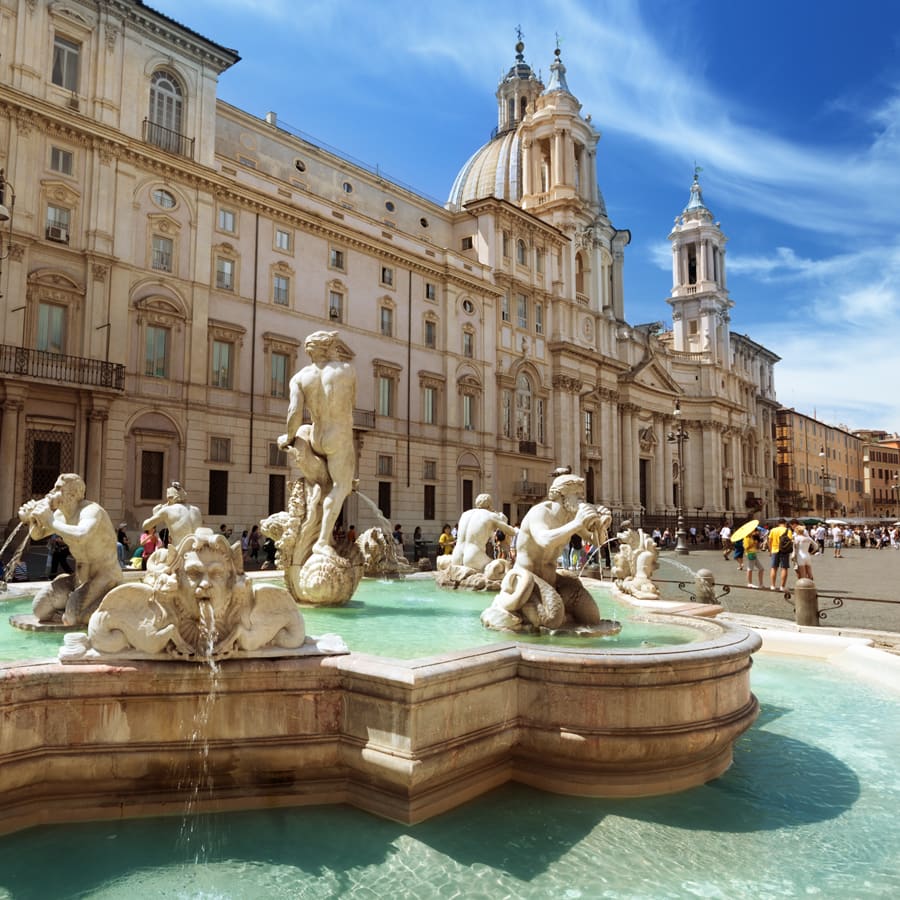
Day 1
Arrive Rome
View More
Day 1
Arrive Rome



11:30 AM
Private Transfer from Rome Fiumicino to Hotel
For your arrival in Rome, we will provide information on the customs and passport procedures. We will schedule a pick up for your flight's arrival time. You will be met at arrivals inside the terminal by a driver holding a sign with your name on it. The transfer is for your party only - you will not be sharing a vehicle. The cost of the ride will be included in your itinerary package and you will be taken directly to your hotel. IMPORTANT NOTE: Please be aware the car service can fit up to 1 checked item of luggage and 1 personal item per person, such as a purse or small backpack. If you think you will have more baggage, please inform your travel consultant as this may result in an additional fee.

Day 1
Arrive Rome
View More


Day 1
Arrive Rome




11:30 AM:
Private Transfer to your Hotel
Mid-Day/Afternoon:
Rome's Historic Center
Late Afternoon/Early Evening:
Spanish Steps


Day 2
Rome
View More
Day 2
Rome




9:00 AM - 12:00 PM
Heart of the Empire - Private Tour of Ancient Rome & the Colosseum
On this 3-hour private guided tour, you will explore the imposing remains of ancient Rome. Your guide will explain the extraordinary history of the birth of Rome, life in the city and everything about the fall of the Empire. Visit the Colosseum, the monumental ruins of the Roman Forum, and end the tour on the Capitoline Hill, the smallest and most important of the seven hills of Ancient Rome.

Colosseum
Ancient Roman Ampitheater
Show More

Colosseum
Ancient Roman Ampitheater
Show More

Colosseum
Ancient Roman Ampitheater
Show More

Colosseum
Ancient Roman Ampitheater
Show More

Colosseum
Ancient Roman Ampitheater
Show More
prev
next

Day 2
Rome
View More

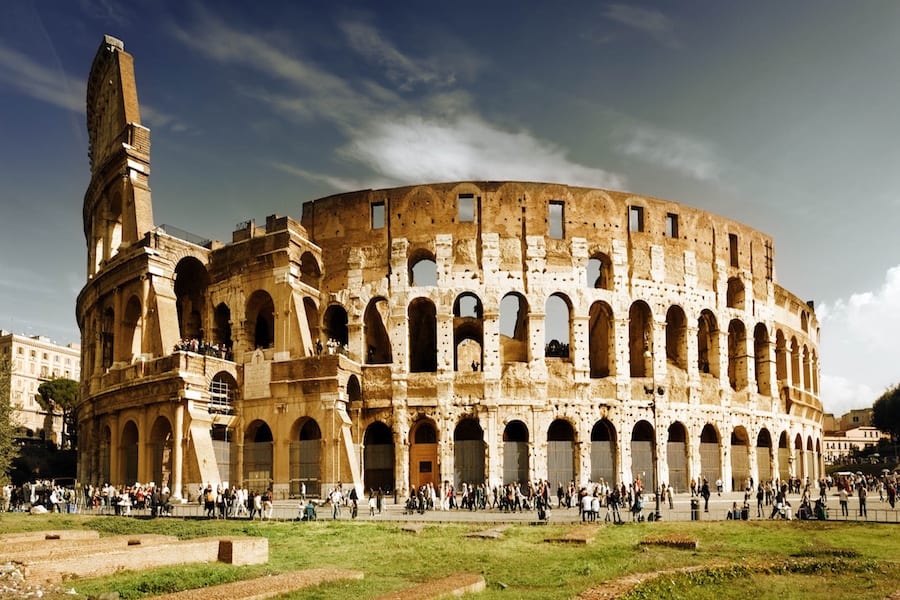
Colosseum
 Highlight of Ancient Rome Guided Walk
Highlight of Ancient Rome Guided WalkAncient Roman Ampitheater
Monumental Roman amphitheater once used for gladiatorial games

Colosseum
 Highlight of Ancient Rome Guided Walk
Highlight of Ancient Rome Guided WalkAncient Roman Ampitheater
Monumental Roman amphitheater once used for gladiatorial games

Colosseum
 Highlight of Ancient Rome Guided Walk
Highlight of Ancient Rome Guided WalkAncient Roman Ampitheater
Monumental Roman amphitheater once used for gladiatorial games

Colosseum
 Highlight of Ancient Rome Guided Walk
Highlight of Ancient Rome Guided WalkAncient Roman Ampitheater
Monumental Roman amphitheater once used for gladiatorial games

Colosseum
 Highlight of Ancient Rome Guided Walk
Highlight of Ancient Rome Guided WalkAncient Roman Ampitheater
Monumental Roman amphitheater once used for gladiatorial games
prev
next


Day 3
Rome
View More
Day 3
Rome




Early Morning to Afternoon
Explore the Vatican City's Many Wonders
Rome is unique in the world in that it contains an independent country within its city limits - the Vatican City, from where the Pope administers the Catholic Church. The symbolic center of Catholicism is St Peter's Basilica, the second-largest Catholic church in the world and among the most beautiful. The Vatican Museum contains one of the greatest collections of art in existence, including Michelangelo's jaw-dropping Sistine Chapel. The popes had a bigger influence on Rome than just the collection of art. The Pope's title is actually Bishop of Rome, and popes administed the city for centuries, shaping its architecture & public spaces. Rome was re-built to be an example of urban beauty, and the Vatican was meant to be the showcase within the showcase. Their success is evident from the throngs of visitors who flock here even today.

Vatican Museums
Book early if you want to see the Vatican Museum's monumental works of art from the greatest Italian artists of the Renaissance.
Show More

St Peter’s Basilica
Explore the gigantic and incredibly beautiful church known as "the greatest of all churches of Christendom".
Show More

Vatican Gardens
Escape the crowds in this oasis of green hidden behind the walls of the Vatican.
Show More

St Peter's Square
Stand in the middle of this famous square in which the faithful gather to hear the Pope give audiences and celebrate mass.
Show More

Sistine Chapel
Gaze up at the world's most famous ceiling, the masterpiece of Michelangelo.
Show More

Vatican Museums
Book early if you want to see the Vatican Museum's monumental works of art from the greatest Italian artists of the Renaissance.
Show More

St Peter’s Basilica
Explore the gigantic and incredibly beautiful church known as "the greatest of all churches of Christendom".
Show More

Vatican Gardens
Escape the crowds in this oasis of green hidden behind the walls of the Vatican.
Show More

St Peter's Square
Stand in the middle of this famous square in which the faithful gather to hear the Pope give audiences and celebrate mass.
Show More

Sistine Chapel
Gaze up at the world's most famous ceiling, the masterpiece of Michelangelo.
Show More

Vatican Museums
Book early if you want to see the Vatican Museum's monumental works of art from the greatest Italian artists of the Renaissance.
Show More
prev
next

Day 3
Rome
View More


Vatican Museums
 Highlight of Vatican City
Highlight of Vatican CityBook early if you want to see the Vatican Museum's monumental works of art from the greatest Italian artists of the Renaissance.
The Vatican Museum is actually 26 different museums, which include not only exhibitions but chapels, apartments, and other rooms of the Vatican palace, covering a huge range of fine and applied arts patronized by the popes. There's also an outstanding collection of ancient antiquities (including even the Emperor Nero's red stone bathtub), a gallery of hand-painted maps, and whole rooms turned into works of art. In addition to ancient and medieval works of art, you'll see masterpieces by the "who's who" of the Italian Renaissance, including Raphael, Leonardo da Vinci, Titian, and Caravaggio. Other highlights include panels by the brilliant monk-artist Fra Angelico, works from the Venetian school, including Vavarini, and much, much more. Booking in advance is highly recommended as otherwise you can wait for hours or not even be able to get in at all.
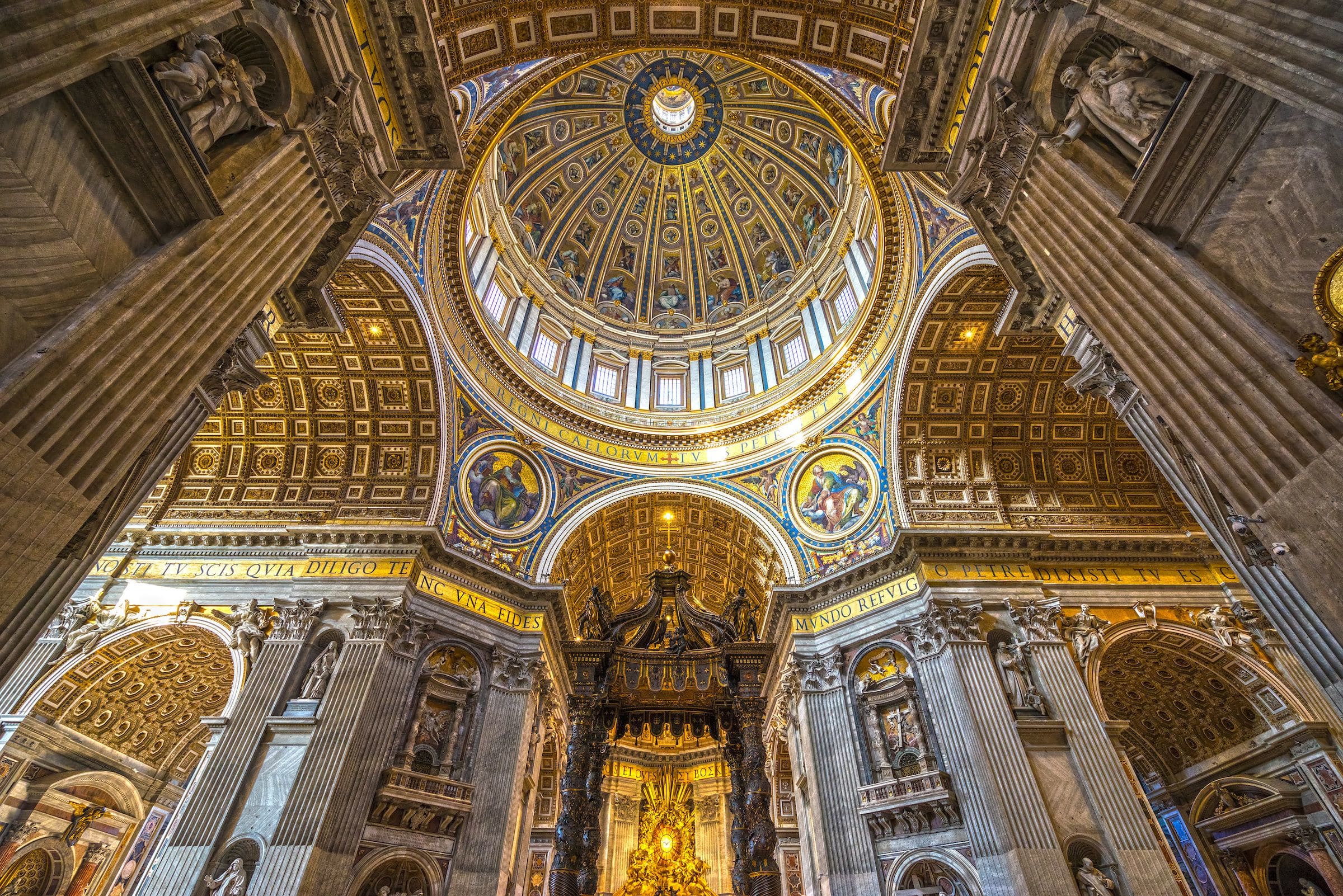
St Peter’s Basilica
 Highlight of Vatican City
Highlight of Vatican CityExplore the gigantic and incredibly beautiful church known as "the greatest of all churches of Christendom".
The basilica is one of the chief pilgrimage sites in the Christian world, and one of the most popular tourist destinations in Rome. The basilica is the symbolic center of the church not only because the Pope frequently celebrates Mass there, but because it is believed that the apostle St. Peter is buried beneath it. Catholics consider Peter as the first Bishop of Rome and "the rock" upon which the Catholic Church was built, in accordance with Christ's instructions. Inside you can admire sculptures by Bernini as well as Michelangelo's famous sculpture of the Virgin Mary holding the crucified Jesus, known as The Pietà. The church's elaborate and impressive golden interior is a sight to behold. Other sights include St Peter's tomb, the Papal crypts in the necropolis under the basilica, as well as the dome, which rewards visitors with views over Rome. Entry is free, but queues to visit the Basilica can be lengthy, so it is highly advised to either get there early or to purchase a skip the line entrance. The dome is also paid entry.

Vatican Gardens
 Highlight of Vatican City
Highlight of Vatican CityEscape the crowds in this oasis of green hidden behind the walls of the Vatican.
Accessible only via a guided tour, the gardens are definitely worth a visit. Just as the Popes have for hundreds of years, you can stroll the gardens and relax amidst the greenery, while taking in the perfect view of St. Peter's.
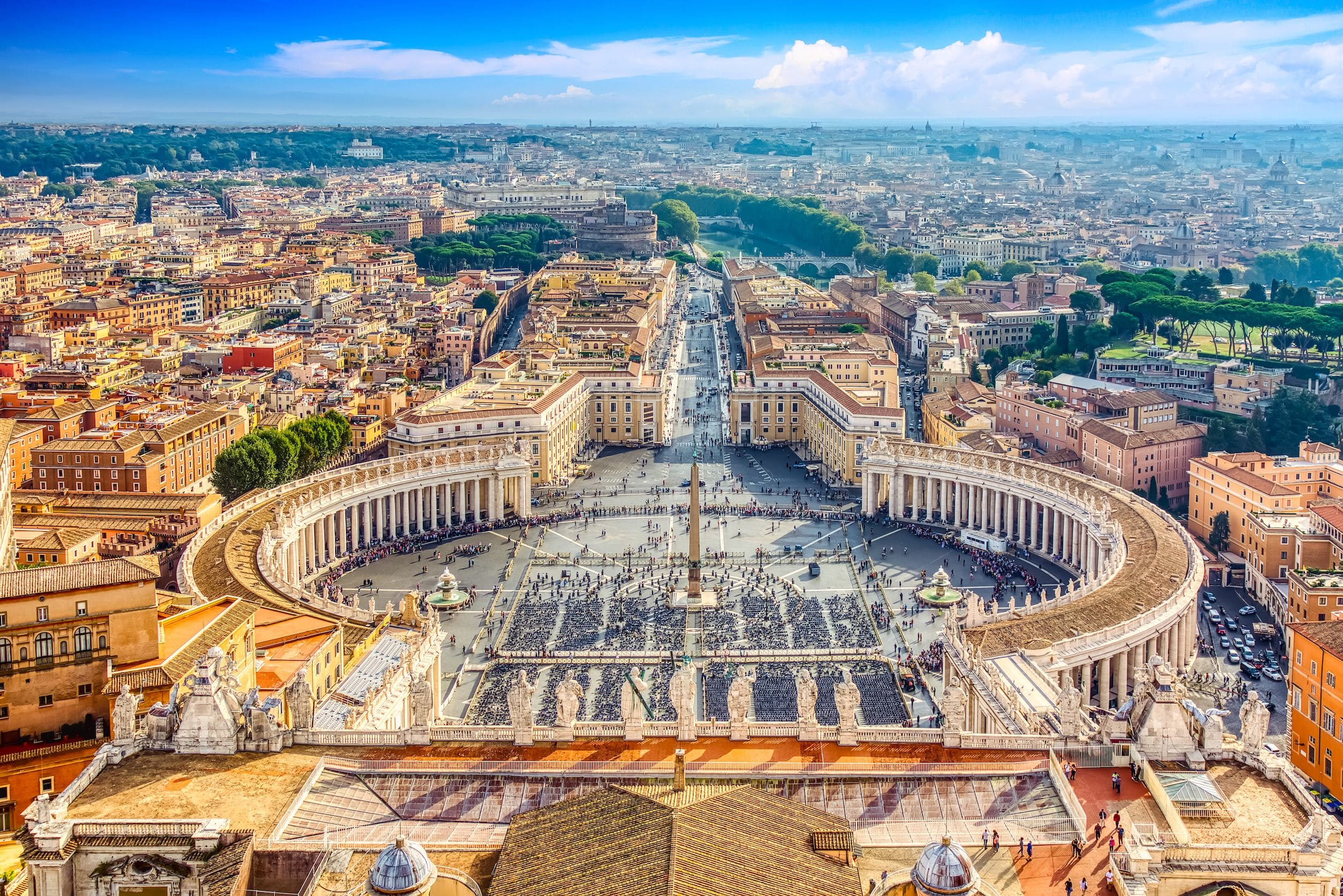
St Peter's Square
 Highlight of Vatican City
Highlight of Vatican CityStand in the middle of this famous square in which the faithful gather to hear the Pope give audiences and celebrate mass.
As one of the most superb conceptions of its kind in civic architecture, St Peter’s Square is the masterpiece of Gian Lorenzo Bernini and makes a wonderful approach to one of the world’s most magnificent churches, St Peter's Basilica. An oval rather than an actual square, the piazza, laid out in 1656-67, is partially enclosed by two semi-circular colonnades on which stand 96 statues of saints and martyrs. At the center of the oval stands an 84-foot (26m) tall Egyptian obelisk of red granite.

Sistine Chapel
 Highlight of Vatican City
Highlight of Vatican CityGaze up at the world's most famous ceiling, the masterpiece of Michelangelo.
This famous chapel inside the Vatican Museums is best known for Michelangelo's 16th-century painted ceiling of "The Creation of Adam" and "The Last Judgement" fresco that covers the whole altar wall of the chapel. The jaw-dropping sight is not to be missed, considered one of the top highlights of visiting the Vatican Museums and one of the top artistic wonders of the world.

Vatican Museums
 Highlight of Vatican City
Highlight of Vatican CityBook early if you want to see the Vatican Museum's monumental works of art from the greatest Italian artists of the Renaissance.
The Vatican Museum is actually 26 different museums, which include not only exhibitions but chapels, apartments, and other rooms of the Vatican palace, covering a huge range of fine and applied arts patronized by the popes. There's also an outstanding collection of ancient antiquities (including even the Emperor Nero's red stone bathtub), a gallery of hand-painted maps, and whole rooms turned into works of art. In addition to ancient and medieval works of art, you'll see masterpieces by the "who's who" of the Italian Renaissance, including Raphael, Leonardo da Vinci, Titian, and Caravaggio. Other highlights include panels by the brilliant monk-artist Fra Angelico, works from the Venetian school, including Vavarini, and much, much more. Booking in advance is highly recommended as otherwise you can wait for hours or not even be able to get in at all.

St Peter’s Basilica
 Highlight of Vatican City
Highlight of Vatican CityExplore the gigantic and incredibly beautiful church known as "the greatest of all churches of Christendom".
The basilica is one of the chief pilgrimage sites in the Christian world, and one of the most popular tourist destinations in Rome. The basilica is the symbolic center of the church not only because the Pope frequently celebrates Mass there, but because it is believed that the apostle St. Peter is buried beneath it. Catholics consider Peter as the first Bishop of Rome and "the rock" upon which the Catholic Church was built, in accordance with Christ's instructions. Inside you can admire sculptures by Bernini as well as Michelangelo's famous sculpture of the Virgin Mary holding the crucified Jesus, known as The Pietà. The church's elaborate and impressive golden interior is a sight to behold. Other sights include St Peter's tomb, the Papal crypts in the necropolis under the basilica, as well as the dome, which rewards visitors with views over Rome. Entry is free, but queues to visit the Basilica can be lengthy, so it is highly advised to either get there early or to purchase a skip the line entrance. The dome is also paid entry.

Vatican Gardens
 Highlight of Vatican City
Highlight of Vatican CityEscape the crowds in this oasis of green hidden behind the walls of the Vatican.
Accessible only via a guided tour, the gardens are definitely worth a visit. Just as the Popes have for hundreds of years, you can stroll the gardens and relax amidst the greenery, while taking in the perfect view of St. Peter's.

St Peter's Square
 Highlight of Vatican City
Highlight of Vatican CityStand in the middle of this famous square in which the faithful gather to hear the Pope give audiences and celebrate mass.
As one of the most superb conceptions of its kind in civic architecture, St Peter’s Square is the masterpiece of Gian Lorenzo Bernini and makes a wonderful approach to one of the world’s most magnificent churches, St Peter's Basilica. An oval rather than an actual square, the piazza, laid out in 1656-67, is partially enclosed by two semi-circular colonnades on which stand 96 statues of saints and martyrs. At the center of the oval stands an 84-foot (26m) tall Egyptian obelisk of red granite.

Sistine Chapel
 Highlight of Vatican City
Highlight of Vatican CityGaze up at the world's most famous ceiling, the masterpiece of Michelangelo.
This famous chapel inside the Vatican Museums is best known for Michelangelo's 16th-century painted ceiling of "The Creation of Adam" and "The Last Judgement" fresco that covers the whole altar wall of the chapel. The jaw-dropping sight is not to be missed, considered one of the top highlights of visiting the Vatican Museums and one of the top artistic wonders of the world.

Vatican Museums
 Highlight of Vatican City
Highlight of Vatican CityBook early if you want to see the Vatican Museum's monumental works of art from the greatest Italian artists of the Renaissance.
The Vatican Museum is actually 26 different museums, which include not only exhibitions but chapels, apartments, and other rooms of the Vatican palace, covering a huge range of fine and applied arts patronized by the popes. There's also an outstanding collection of ancient antiquities (including even the Emperor Nero's red stone bathtub), a gallery of hand-painted maps, and whole rooms turned into works of art. In addition to ancient and medieval works of art, you'll see masterpieces by the "who's who" of the Italian Renaissance, including Raphael, Leonardo da Vinci, Titian, and Caravaggio. Other highlights include panels by the brilliant monk-artist Fra Angelico, works from the Venetian school, including Vavarini, and much, much more. Booking in advance is highly recommended as otherwise you can wait for hours or not even be able to get in at all.
prev
next


Day 4
Rome to Florence
View More
Day 4
Rome to Florence





Morning/Mid-Day
Visit Rome's Esquilino District
Upon first glance, this urban neighborhood of Rome may seem busy and overwhelming, but hidden among its traffic-noisy streets are some of Rome's most beautiful churches, artistic treasures, and cultural museums, including the Baths of Diocletian.

Basilica of Santa Maria degli Angeli
See a Michelangelo-designed church built within the former Baths of Diocletian.
Show More

Palazzo Massimo alle Terme
Visit one of Rome's greatest but most unheralded museums of antiquity.
Show More

Baths of Diocletian
Walk the ruins of what was once the largest themal baths in the ancient Roman world.
Show More

Basilica of Santa Maria degli Angeli
See a Michelangelo-designed church built within the former Baths of Diocletian.
Show More

Palazzo Massimo alle Terme
Visit one of Rome's greatest but most unheralded museums of antiquity.
Show More

Baths of Diocletian
Walk the ruins of what was once the largest themal baths in the ancient Roman world.
Show More

Basilica of Santa Maria degli Angeli
See a Michelangelo-designed church built within the former Baths of Diocletian.
Show More
prev
next

Day 4
Rome to Florence
View More

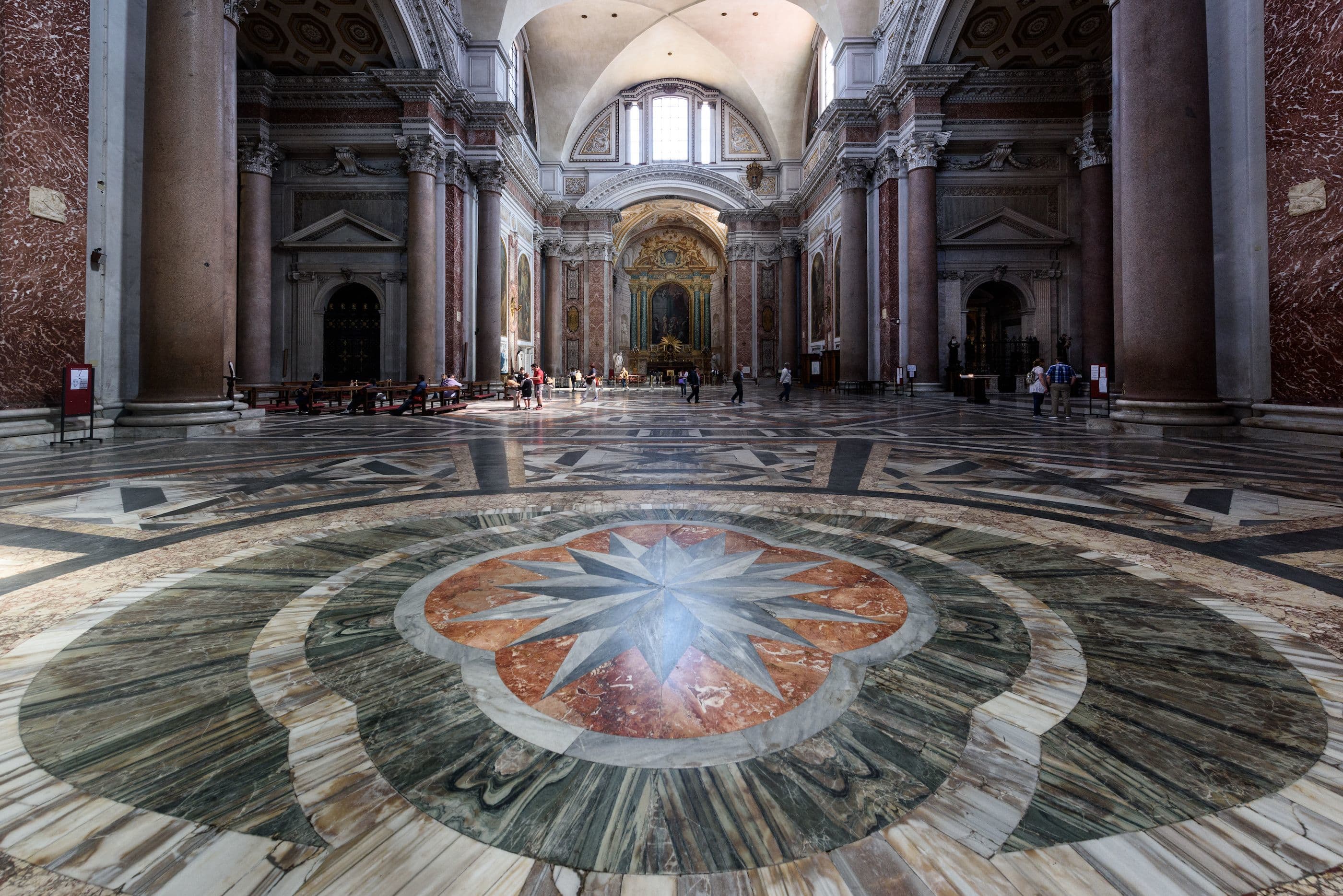
Basilica of Santa Maria degli Angeli
 Highlight of Esquilino District
Highlight of Esquilino DistrictSee a Michelangelo-designed church built within the former Baths of Diocletian.
In 1561, almost 1000 years after the baths of Diocletian fell into disuse, Pope Pius IV decided to build a basilica consecrated to Our Lady of the Angels within the baths. He commisioned the 86-year-old Michelangelo to plan the church, making use of some of the existing structures of the baths. Today a visit to the basilica gives you an idea of the enormous size of the baths. The church was constructed at the site of the former frigidarium (a large cold pool which would be used to close the pores after using the hot baths) and incorporates several elements of the former thermae. The vestibule occupies the former tepidarium (a Roman-style relaxation room) and the imposing entrance is an exedra of the caldarium (a room with a hot plunge bath). Other highlights include the meridian solar line running across the floor, which still accurately calculates the length of the year and the summer and winter solstices. There is also an impressive organ with 5,400 tubes. It is capable of leaving those visitors lucky enough to hear it spellbound.
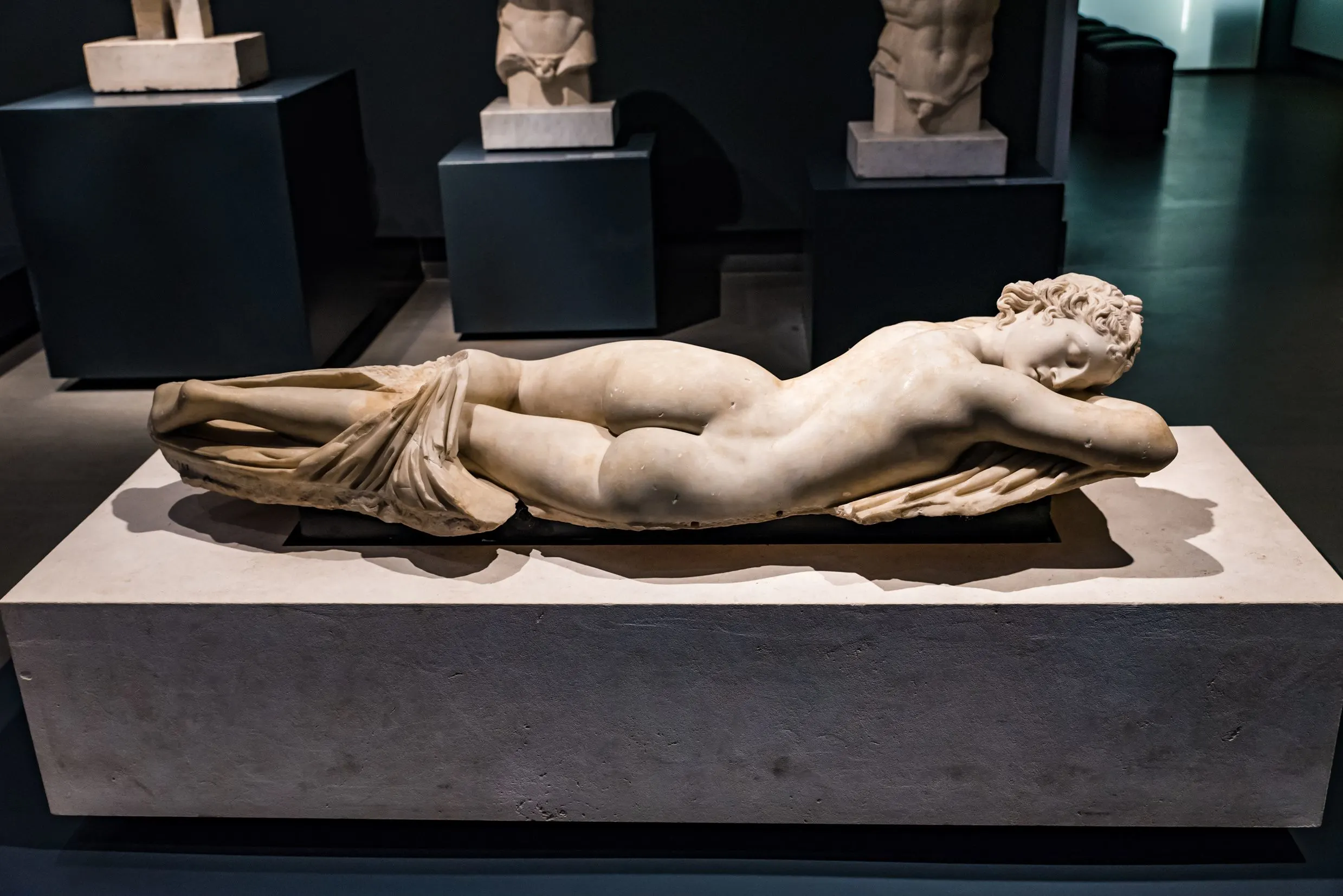
Palazzo Massimo alle Terme
 Highlight of Esquilino District
Highlight of Esquilino DistrictVisit one of Rome's greatest but most unheralded museums of antiquity.
This light-filled museum holds one of the best classical art collections in the world. The ground and first-floor feature famous Greek and Roman sculptures, mosaics and statues, as well as impressive sarcophagi and high reliefs. The second floor showcases the best preserved Roman frescoes in the world, which are considered the highlight of the museum. Originally located in Villa of Livia (the wife of Augustus) and Villa Farnesina, these colourful frescoes, sometimes covering an entire room, offer a unique view into life in ancient Rome and the critical importance of gardens, nature, and the villa atmosphere to upper echelon Romans. A must visit room is the painted garden room of Villa Livia. There is also a cinema room with a video showing a 3D reconstruction of the Villa Farnesina as it would have been, showing the layout of the rooms in the villa and the frescoes you had seen just moments before.

Baths of Diocletian
 Highlight of Esquilino District
Highlight of Esquilino DistrictWalk the ruins of what was once the largest themal baths in the ancient Roman world.
Covering an area of more than 13 hectares (some 32 acres), the bath complex was commissioned by Emperor Diocletian in 298 AD, with a capacity to host over 3,000 people (twice as many as the Baths of Caracalla). The baths were made of bricks, coated in marble and decorated with mosaics and sculptures. The complex included a gymnasium, a library, a large outdoor swimming pool and cold, hot, and tepid public baths. They remained open until 537 when the Goths cut off the aqueducts in an attempt to conquer Rome. After they fell into disrepair and were left abandoned. Even though only a small part of the public bath complex can be seen and visited, it is extremely impressive, with the possibility to see at some points the high ceilings the baths possessed. The interior includes part of the National Museum of Rome and a permanent exhibition on pre-historic populations of the area. In the outdoor part of the baths, it is possible to stroll through a sixteenth-century garden with nearly 400 works of art, including statues, sarcophagi and reliefs.

Basilica of Santa Maria degli Angeli
 Highlight of Esquilino District
Highlight of Esquilino DistrictSee a Michelangelo-designed church built within the former Baths of Diocletian.
In 1561, almost 1000 years after the baths of Diocletian fell into disuse, Pope Pius IV decided to build a basilica consecrated to Our Lady of the Angels within the baths. He commisioned the 86-year-old Michelangelo to plan the church, making use of some of the existing structures of the baths. Today a visit to the basilica gives you an idea of the enormous size of the baths. The church was constructed at the site of the former frigidarium (a large cold pool which would be used to close the pores after using the hot baths) and incorporates several elements of the former thermae. The vestibule occupies the former tepidarium (a Roman-style relaxation room) and the imposing entrance is an exedra of the caldarium (a room with a hot plunge bath). Other highlights include the meridian solar line running across the floor, which still accurately calculates the length of the year and the summer and winter solstices. There is also an impressive organ with 5,400 tubes. It is capable of leaving those visitors lucky enough to hear it spellbound.

Palazzo Massimo alle Terme
 Highlight of Esquilino District
Highlight of Esquilino DistrictVisit one of Rome's greatest but most unheralded museums of antiquity.
This light-filled museum holds one of the best classical art collections in the world. The ground and first-floor feature famous Greek and Roman sculptures, mosaics and statues, as well as impressive sarcophagi and high reliefs. The second floor showcases the best preserved Roman frescoes in the world, which are considered the highlight of the museum. Originally located in Villa of Livia (the wife of Augustus) and Villa Farnesina, these colourful frescoes, sometimes covering an entire room, offer a unique view into life in ancient Rome and the critical importance of gardens, nature, and the villa atmosphere to upper echelon Romans. A must visit room is the painted garden room of Villa Livia. There is also a cinema room with a video showing a 3D reconstruction of the Villa Farnesina as it would have been, showing the layout of the rooms in the villa and the frescoes you had seen just moments before.

Baths of Diocletian
 Highlight of Esquilino District
Highlight of Esquilino DistrictWalk the ruins of what was once the largest themal baths in the ancient Roman world.
Covering an area of more than 13 hectares (some 32 acres), the bath complex was commissioned by Emperor Diocletian in 298 AD, with a capacity to host over 3,000 people (twice as many as the Baths of Caracalla). The baths were made of bricks, coated in marble and decorated with mosaics and sculptures. The complex included a gymnasium, a library, a large outdoor swimming pool and cold, hot, and tepid public baths. They remained open until 537 when the Goths cut off the aqueducts in an attempt to conquer Rome. After they fell into disrepair and were left abandoned. Even though only a small part of the public bath complex can be seen and visited, it is extremely impressive, with the possibility to see at some points the high ceilings the baths possessed. The interior includes part of the National Museum of Rome and a permanent exhibition on pre-historic populations of the area. In the outdoor part of the baths, it is possible to stroll through a sixteenth-century garden with nearly 400 works of art, including statues, sarcophagi and reliefs.

Basilica of Santa Maria degli Angeli
 Highlight of Esquilino District
Highlight of Esquilino DistrictSee a Michelangelo-designed church built within the former Baths of Diocletian.
In 1561, almost 1000 years after the baths of Diocletian fell into disuse, Pope Pius IV decided to build a basilica consecrated to Our Lady of the Angels within the baths. He commisioned the 86-year-old Michelangelo to plan the church, making use of some of the existing structures of the baths. Today a visit to the basilica gives you an idea of the enormous size of the baths. The church was constructed at the site of the former frigidarium (a large cold pool which would be used to close the pores after using the hot baths) and incorporates several elements of the former thermae. The vestibule occupies the former tepidarium (a Roman-style relaxation room) and the imposing entrance is an exedra of the caldarium (a room with a hot plunge bath). Other highlights include the meridian solar line running across the floor, which still accurately calculates the length of the year and the summer and winter solstices. There is also an impressive organ with 5,400 tubes. It is capable of leaving those visitors lucky enough to hear it spellbound.
prev
next

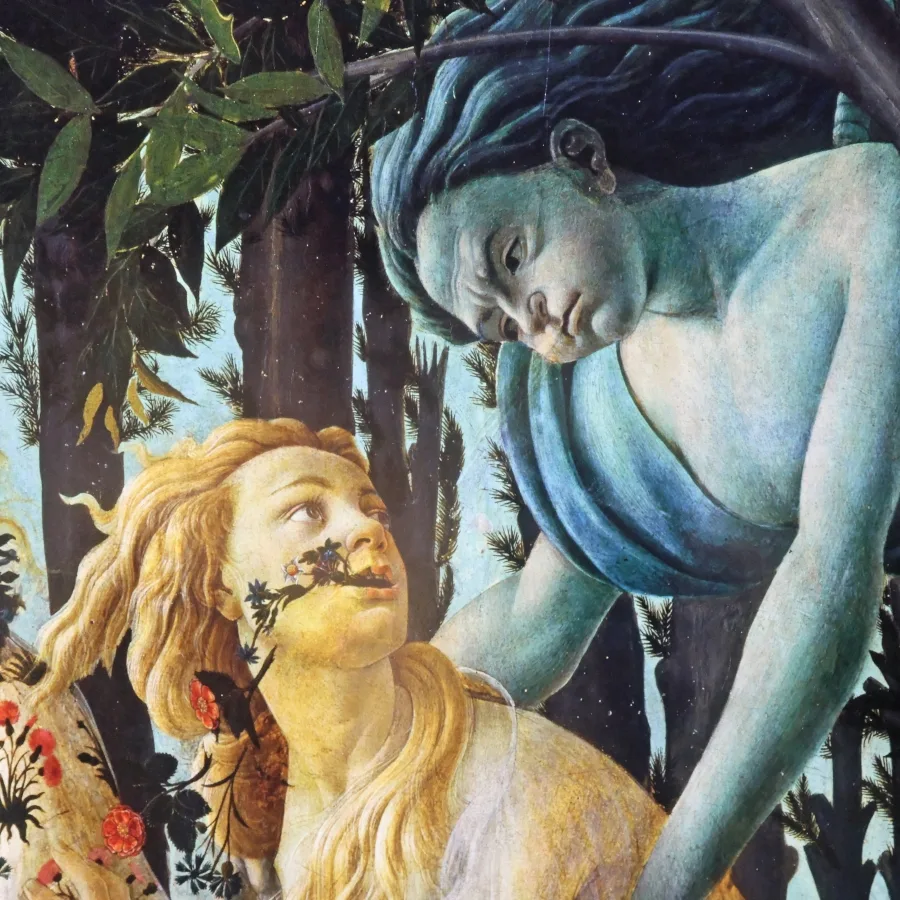
Day 5
Florence
View More
Day 5
Florence




Morning/Mid-Day
Visit Italy's Greatest Display of Art at the Uffizi Gallery
As the capital of the Renaissance, it's only fitting that Florence should also host Italy's greatest art gallery at the Uffizi. It's understandably busy throughout the year, but it's nevertheless worth the crowds to see to see some of the most sumptuous masterpieces of Renaissance art, including Botticelli's Primavera and Venus, and works by Michelangelo and Da Vinci. If you're planning to visit other galleries and museums in Florence, then it's definitely worth investing in a Firenze Card, which gives you free entry and priority access to 72 venues in the city. At a minimum, you should book ahead for the Uffizi to avoid very long queues.

Day 5
Florence
View More


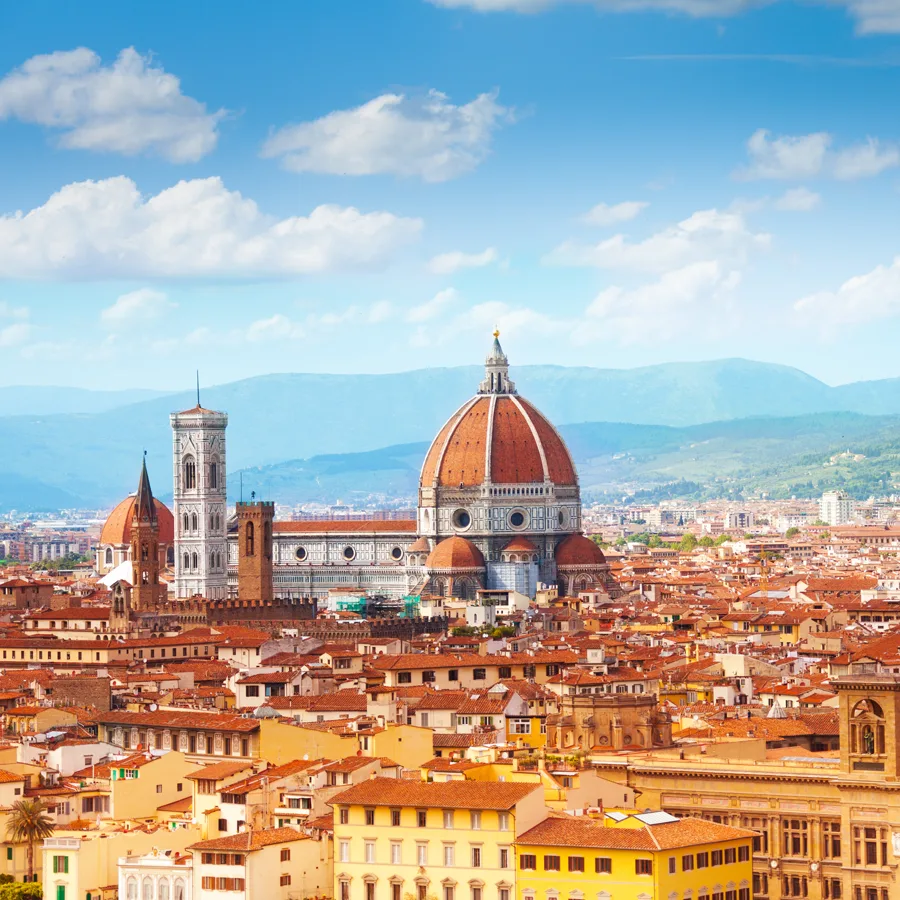
Day 6
Florence
View More
Day 6
Florence



9:00 AM - 12:00 PM
Best of Florence: Half-Day Walking Tour
Enjoy a 3-hour private walking tour of Florence, the perfect introduction to the masterpieces of this city. Stroll around the historic center and take in sights such as the Palazzo Vecchio, Ponte Vecchio, Piazza Della Signora and end your tour at the famous Galleria dell'Accademia where you can enter to see Michelangelo's marble masterpiece, the statue of David.

Galleria dell'Accademia
Art museum and home to Michelangelo's famous David
Show More

Galleria dell'Accademia
Art museum and home to Michelangelo's famous David
Show More

Galleria dell'Accademia
Art museum and home to Michelangelo's famous David
Show More

Galleria dell'Accademia
Art museum and home to Michelangelo's famous David
Show More

Galleria dell'Accademia
Art museum and home to Michelangelo's famous David
Show More
prev
next

Day 6
Florence
View More

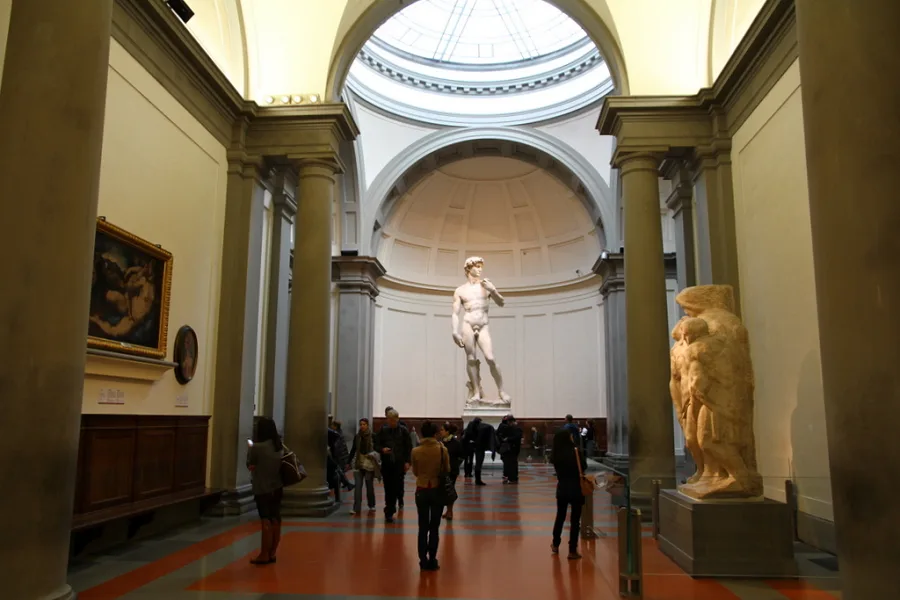
Galleria dell'Accademia
 Highlight of Private Guided Walk in Florence
Highlight of Private Guided Walk in FlorenceArt museum and home to Michelangelo's famous David
The Gallery's prized exhibits are naturally its works by Michelangelo, including in addition to David his unfinished Slaves (or Prisoners).

Galleria dell'Accademia
 Highlight of Private Guided Walk in Florence
Highlight of Private Guided Walk in FlorenceArt museum and home to Michelangelo's famous David
The Gallery's prized exhibits are naturally its works by Michelangelo, including in addition to David his unfinished Slaves (or Prisoners).

Galleria dell'Accademia
 Highlight of Private Guided Walk in Florence
Highlight of Private Guided Walk in FlorenceArt museum and home to Michelangelo's famous David
The Gallery's prized exhibits are naturally its works by Michelangelo, including in addition to David his unfinished Slaves (or Prisoners).

Galleria dell'Accademia
 Highlight of Private Guided Walk in Florence
Highlight of Private Guided Walk in FlorenceArt museum and home to Michelangelo's famous David
The Gallery's prized exhibits are naturally its works by Michelangelo, including in addition to David his unfinished Slaves (or Prisoners).

Galleria dell'Accademia
 Highlight of Private Guided Walk in Florence
Highlight of Private Guided Walk in FlorenceArt museum and home to Michelangelo's famous David
The Gallery's prized exhibits are naturally its works by Michelangelo, including in addition to David his unfinished Slaves (or Prisoners).
prev
next

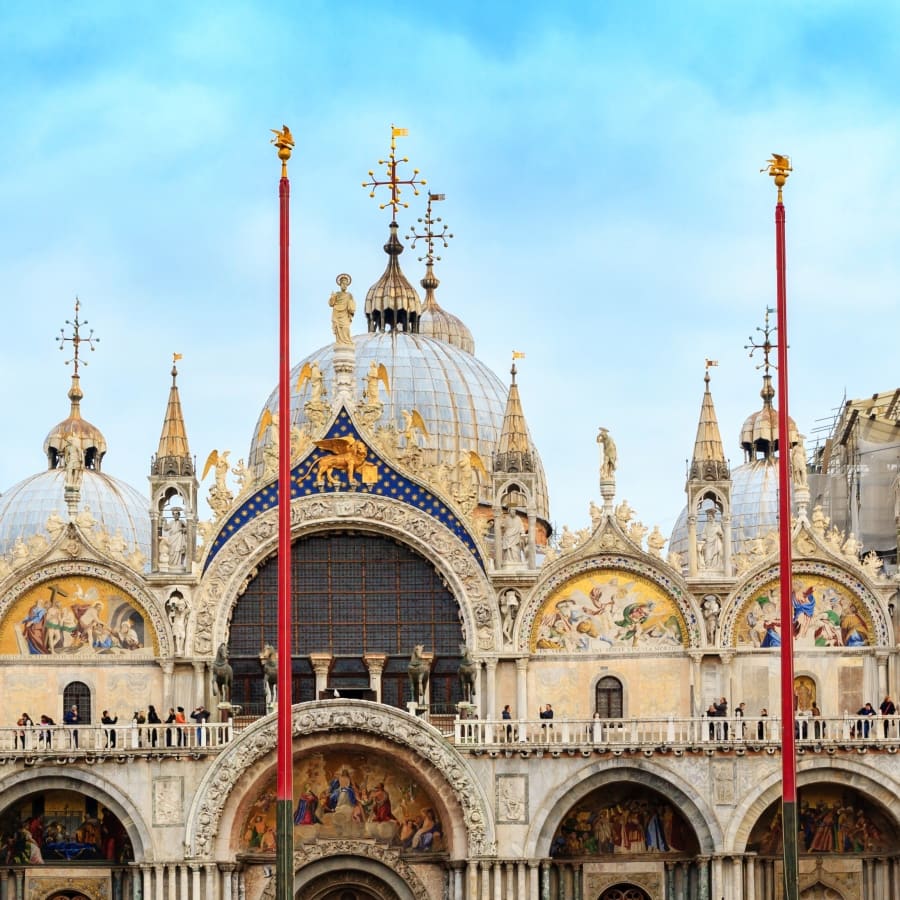
Day 7
Florence to Venice
View More
Day 7
Florence to Venice





9:20 AM
Transfer to Station by Taxi or Public Transport
Most trains depart from Firenza S.M.N. (i.e. Florence Santa Maria Novella Station) station, the largest station in the city. Before spending money on a transfer, be sure to check whether your hotel is within easy walking distance. Also consider that public transport is the cheapest and sometimes fastest option; trams and buses drop off next to the station. Uber is available in Florence, and if staying at a hotel, they can order a reliable taxi. Some private transfers will even help with your bags.

Day 7
Florence to Venice
View More



Day 8
Venice
View More
Day 8
Venice




Morning/Mid-Day
Rialto Bridge & San Polo District
The graceful arch of the Rialto Bridge is perhaps the single most iconic sight in Venice since nearly everyone passes beneath it on their journey along the Grand Canal. It connects Venice's two most visited districts, San Marco and San Polo. While San Marco is famous for St. Mark's Square, San Polo more than holds its own as a must-see destination, as it contains some of the city's oldest neighborhoods and most picturesque canals and bridges. It is also home to some of the best restaurants in Venice, and admittedly some of its worst tourist traps as well. Among many highlights is the bustling Rialto Market, which was once one of medieval Europe's busiest financial and trade markets, and still does a brisk trade in fresh seafood and produce.

Frari Church
Step inside this inconspicuous Gothic 15th-century church to discover some of Venice's most famous tombs and artwork.
Show More

Scuola Grande di San Rocco
Visit this underrated art museum featuring works by the famed Renaissance artist Tintoretto.
Show More

Rialto Bridge
Walk over or ride under the most famous bridge on the Grand Canal.
Show More

Rialto Markets
Experience the sights, tastes, and smells of Venice's historic "Pescaria" fish market, as well as the fresh produce market.
Show More

Frari Church
Step inside this inconspicuous Gothic 15th-century church to discover some of Venice's most famous tombs and artwork.
Show More

Scuola Grande di San Rocco
Visit this underrated art museum featuring works by the famed Renaissance artist Tintoretto.
Show More

Rialto Bridge
Walk over or ride under the most famous bridge on the Grand Canal.
Show More

Rialto Markets
Experience the sights, tastes, and smells of Venice's historic "Pescaria" fish market, as well as the fresh produce market.
Show More
prev
next

Day 8
Venice
View More

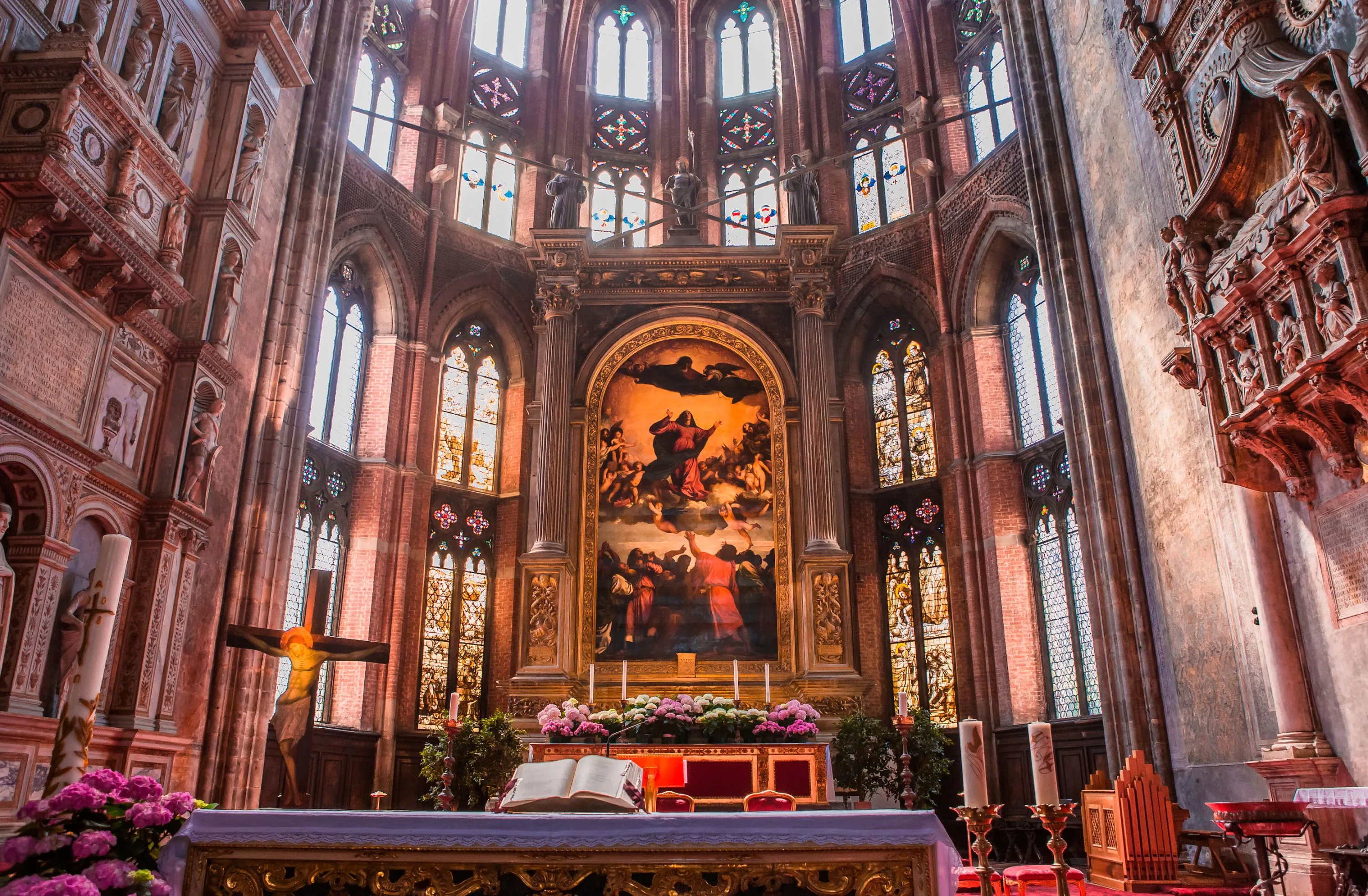
Frari Church
 Highlight of San Polo District
Highlight of San Polo DistrictStep inside this inconspicuous Gothic 15th-century church to discover some of Venice's most famous tombs and artwork.
The relatively austere brick Gothic Church of Santa Maria Gloriosa dei Frari holds many surprises. It has the second tallest campanile in Venice after St Mark's, and contains numerous masterpieces of painting and sculpture by the likes of Titian, Bellini and Donatello, plus a number of important doges' tombs, as well as Titian's tomb. Titian's majestic painting of The Assumption in the sanctuary, with its dramatic movement and coloring, is the work that established Titian's reputation as one of the greatest of all Italian painters. Even if you feel you've seen too many churches already, this one is definitely worth visiting and we recommend investing in the audio guide to get the best out of your time here.

Scuola Grande di San Rocco
 Highlight of San Polo District
Highlight of San Polo DistrictVisit this underrated art museum featuring works by the famed Renaissance artist Tintoretto.
Next door to the Frari, one of the most magnificent of Venice's charitable associations, The Scuola Grande di San Rocco is one of the most magnificent of Venice's charitable associations. The building was completed in 1560, and Tintoretto won a competition held to select an artist to decorate the interior. Over the next 23 years, he executed an incomparable series of paintings that cover the walls and ceilings. According to the writer Jan Morris, "no collection of sacred pictures is more overwhelming of impact than the immense series of Tintorettos in the Scuola [...] - often dark, often grandiose, often incomprehensible, but culminating in the huge masterpiece of the Crucifixion, which Velazquez humbly copied, and before which, to this day, you may still see strong men moved to tears."

Rialto Bridge
 Highlight of San Polo District
Highlight of San Polo DistrictWalk over or ride under the most famous bridge on the Grand Canal.
The 16th-century Rialto Bridge is the most iconic bridge in Venice. With a width of other 75 feet (23m) and span of over 100 feet (31m), the wide stone footbridge crosses over the Grand Canal and connects the San Marco and San Polo districts. It stands on the spot of an earlier wooden drawbridge which collapsed under the weight of a crowd gathered on it to watch a wedding procession. It took almost 150 years before the current Rialto bridge was built, this time in stone, and thus still stands as a symbol of the city. Surrounded by tourist shops and pricey restaurants, it sits on 12,000 wooden pilings and will be forever immortalised in millions of photographs as the backdrop to the classic Venetian photo shot, which captures the city's gondolas as they ferry lovers around the Grand Canal. While for many a gondola ride is a must-do experience in Venice, it's also possible to admire the bridge on foot. For a less-pricey way of seeing it from the water, you can always take the Number 1 local Vaporetto (water bus) and see the bridge as you pass underneath.
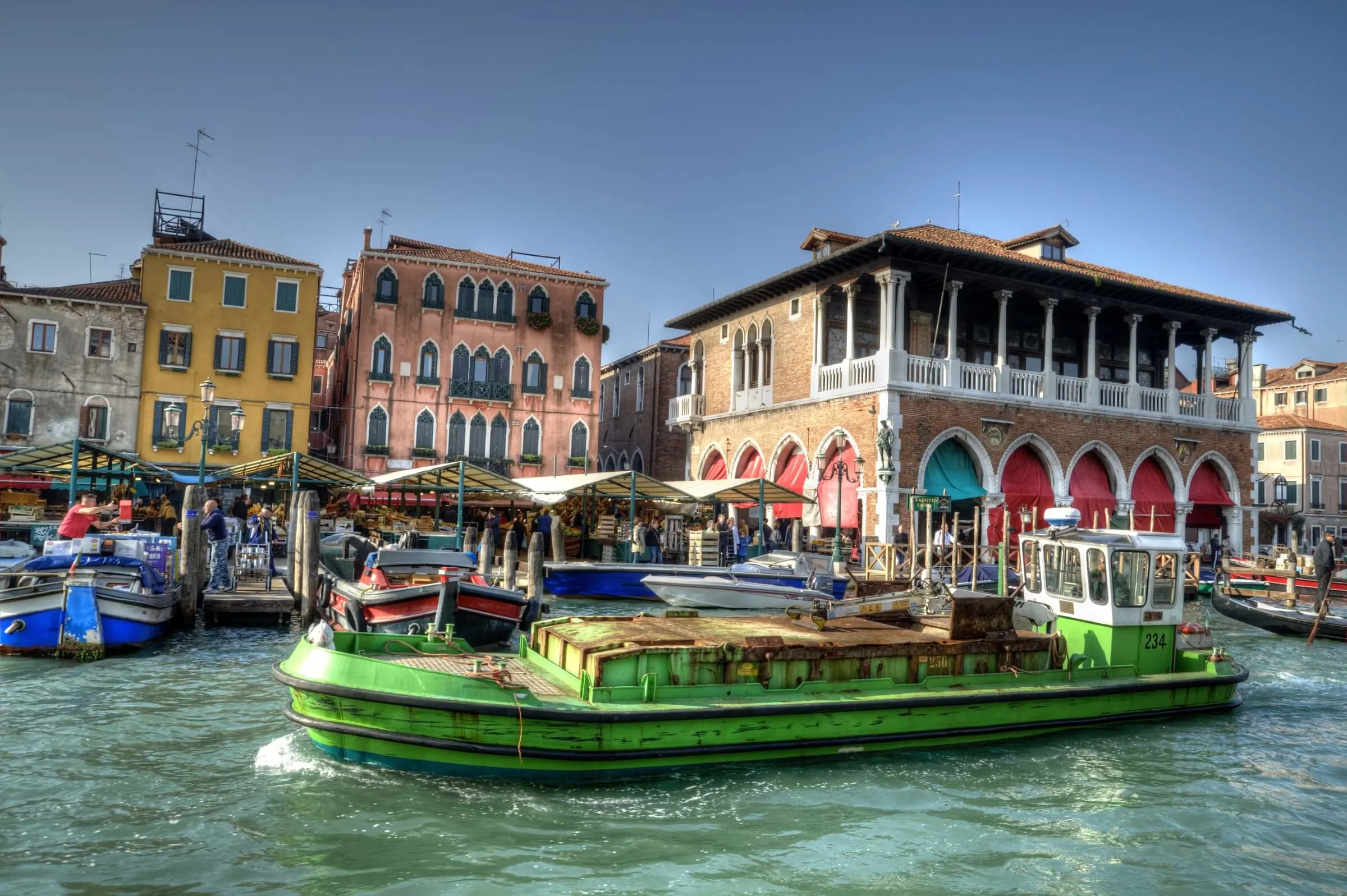
Rialto Markets
 Highlight of San Polo District
Highlight of San Polo DistrictExperience the sights, tastes, and smells of Venice's historic "Pescaria" fish market, as well as the fresh produce market.
Located close to the Rialto Bridge stands the Rialto Market, "the incomparable fish market of Venice, a glorious wet, colorful, high-smelling concourse of the sea, to which in the down hours fleets of barges bring the day's supply of sea-foods" (Jan Morris). Established well before the bridge was built, Venice's iconic market is a sight to behold, with colourful vegetable stalls and loud market vendors touting for business. It is a great spot for photographs and of course for a taste of the freshly caught fish with a host of appetising snacks on offer. Adjacent to the fish market you'll find a produce market, which is also important for a city which demands fresh ingredients for its cuisine. Keep in mind that the markets close at 1pm, and both markets are closed on Sundays (the fish market is also closed on Mondays).

Frari Church
 Highlight of San Polo District
Highlight of San Polo DistrictStep inside this inconspicuous Gothic 15th-century church to discover some of Venice's most famous tombs and artwork.
The relatively austere brick Gothic Church of Santa Maria Gloriosa dei Frari holds many surprises. It has the second tallest campanile in Venice after St Mark's, and contains numerous masterpieces of painting and sculpture by the likes of Titian, Bellini and Donatello, plus a number of important doges' tombs, as well as Titian's tomb. Titian's majestic painting of The Assumption in the sanctuary, with its dramatic movement and coloring, is the work that established Titian's reputation as one of the greatest of all Italian painters. Even if you feel you've seen too many churches already, this one is definitely worth visiting and we recommend investing in the audio guide to get the best out of your time here.

Scuola Grande di San Rocco
 Highlight of San Polo District
Highlight of San Polo DistrictVisit this underrated art museum featuring works by the famed Renaissance artist Tintoretto.
Next door to the Frari, one of the most magnificent of Venice's charitable associations, The Scuola Grande di San Rocco is one of the most magnificent of Venice's charitable associations. The building was completed in 1560, and Tintoretto won a competition held to select an artist to decorate the interior. Over the next 23 years, he executed an incomparable series of paintings that cover the walls and ceilings. According to the writer Jan Morris, "no collection of sacred pictures is more overwhelming of impact than the immense series of Tintorettos in the Scuola [...] - often dark, often grandiose, often incomprehensible, but culminating in the huge masterpiece of the Crucifixion, which Velazquez humbly copied, and before which, to this day, you may still see strong men moved to tears."

Rialto Bridge
 Highlight of San Polo District
Highlight of San Polo DistrictWalk over or ride under the most famous bridge on the Grand Canal.
The 16th-century Rialto Bridge is the most iconic bridge in Venice. With a width of other 75 feet (23m) and span of over 100 feet (31m), the wide stone footbridge crosses over the Grand Canal and connects the San Marco and San Polo districts. It stands on the spot of an earlier wooden drawbridge which collapsed under the weight of a crowd gathered on it to watch a wedding procession. It took almost 150 years before the current Rialto bridge was built, this time in stone, and thus still stands as a symbol of the city. Surrounded by tourist shops and pricey restaurants, it sits on 12,000 wooden pilings and will be forever immortalised in millions of photographs as the backdrop to the classic Venetian photo shot, which captures the city's gondolas as they ferry lovers around the Grand Canal. While for many a gondola ride is a must-do experience in Venice, it's also possible to admire the bridge on foot. For a less-pricey way of seeing it from the water, you can always take the Number 1 local Vaporetto (water bus) and see the bridge as you pass underneath.

Rialto Markets
 Highlight of San Polo District
Highlight of San Polo DistrictExperience the sights, tastes, and smells of Venice's historic "Pescaria" fish market, as well as the fresh produce market.
Located close to the Rialto Bridge stands the Rialto Market, "the incomparable fish market of Venice, a glorious wet, colorful, high-smelling concourse of the sea, to which in the down hours fleets of barges bring the day's supply of sea-foods" (Jan Morris). Established well before the bridge was built, Venice's iconic market is a sight to behold, with colourful vegetable stalls and loud market vendors touting for business. It is a great spot for photographs and of course for a taste of the freshly caught fish with a host of appetising snacks on offer. Adjacent to the fish market you'll find a produce market, which is also important for a city which demands fresh ingredients for its cuisine. Keep in mind that the markets close at 1pm, and both markets are closed on Sundays (the fish market is also closed on Mondays).
prev
next


Day 9
Venice to Milan
View More
Day 9
Venice to Milan




Morning/Mid-Day
Visit the Dorsoduro District
Discover the less well-known sestiere (district) of Dorsoduro and visit its world-famous art collections at Gallerie dell'Academia, the Peggy Guggenheim Collection, and Cà Rezzonico. Once a haven for artists before rising rents drove them out, it is still a charming and unique district with many lively spots, such as the Campo Santa Margherita, one of Venice's largest squares. Be sure to take a walk along its enchanting waterfront promenade known as Zattere and explore the cafes along its canals.

Peggy Guggenheim Collection
See the rich collection of 20th-century art inside one of Europe's most important museums.
Show More

Ca' Rezzonico
Acquaint yourself with Venetian art of the 18th century and get a taste of what it was like to live in a fabulously ornate palace.
Show More

Ponte dell'Accademia
Catch the iconic photo of the Grand Canal from the this attractive wood and metal bridge.
Show More

Gallerie Dell'Accademia
See the incredible masterpieces held within Venice's most renowned art gallery.
Show More

The Gesuati
Watch the sun set from the steps of this beautifully decorated 18th-century church.
Show More

Peggy Guggenheim Collection
See the rich collection of 20th-century art inside one of Europe's most important museums.
Show More

Ca' Rezzonico
Acquaint yourself with Venetian art of the 18th century and get a taste of what it was like to live in a fabulously ornate palace.
Show More

Ponte dell'Accademia
Catch the iconic photo of the Grand Canal from the this attractive wood and metal bridge.
Show More

Gallerie Dell'Accademia
See the incredible masterpieces held within Venice's most renowned art gallery.
Show More

The Gesuati
Watch the sun set from the steps of this beautifully decorated 18th-century church.
Show More

Peggy Guggenheim Collection
See the rich collection of 20th-century art inside one of Europe's most important museums.
Show More
prev
next

Day 9
Venice to Milan
View More


Peggy Guggenheim Collection
 Highlight of The Dorsoduro District
Highlight of The Dorsoduro DistrictSee the rich collection of 20th-century art inside one of Europe's most important museums.
The Peggy Guggenheim Museum is one of the top sights in Venice, not just for art lovers. Housed in the Palazzo Venier dei Leoni, this was the former residence of the flamboyant copper heiress Peggy Guggenheim from 1949 until her death 30 years later. It houses masterpieces ranging from Cubism and Surrealism to Abstract Expressionism from artists such as Magritte, Picasso, Ernst and Miro.

Ca' Rezzonico
 Highlight of The Dorsoduro District
Highlight of The Dorsoduro DistrictAcquaint yourself with Venetian art of the 18th century and get a taste of what it was like to live in a fabulously ornate palace.
Ca' Rezzonico is one of the most important 17th-18th-century palaces in Venice, abd it now houses the Museo del Settecento Veneziano, the city's collection of 18th-century art. Apart from some wonderful paintings by Tiepolo in addition to his ceiling frescoes, the museum also contains Venetian scenes painted by the brilliant landscape artist, Canaletto. Of course it is not just the art hanging on the walls that visitors come for, but the artistry of the building itself. The beautifully decorated interior, including colorful frescoes and ornate marble staircases, is well worth seeing in its own right.
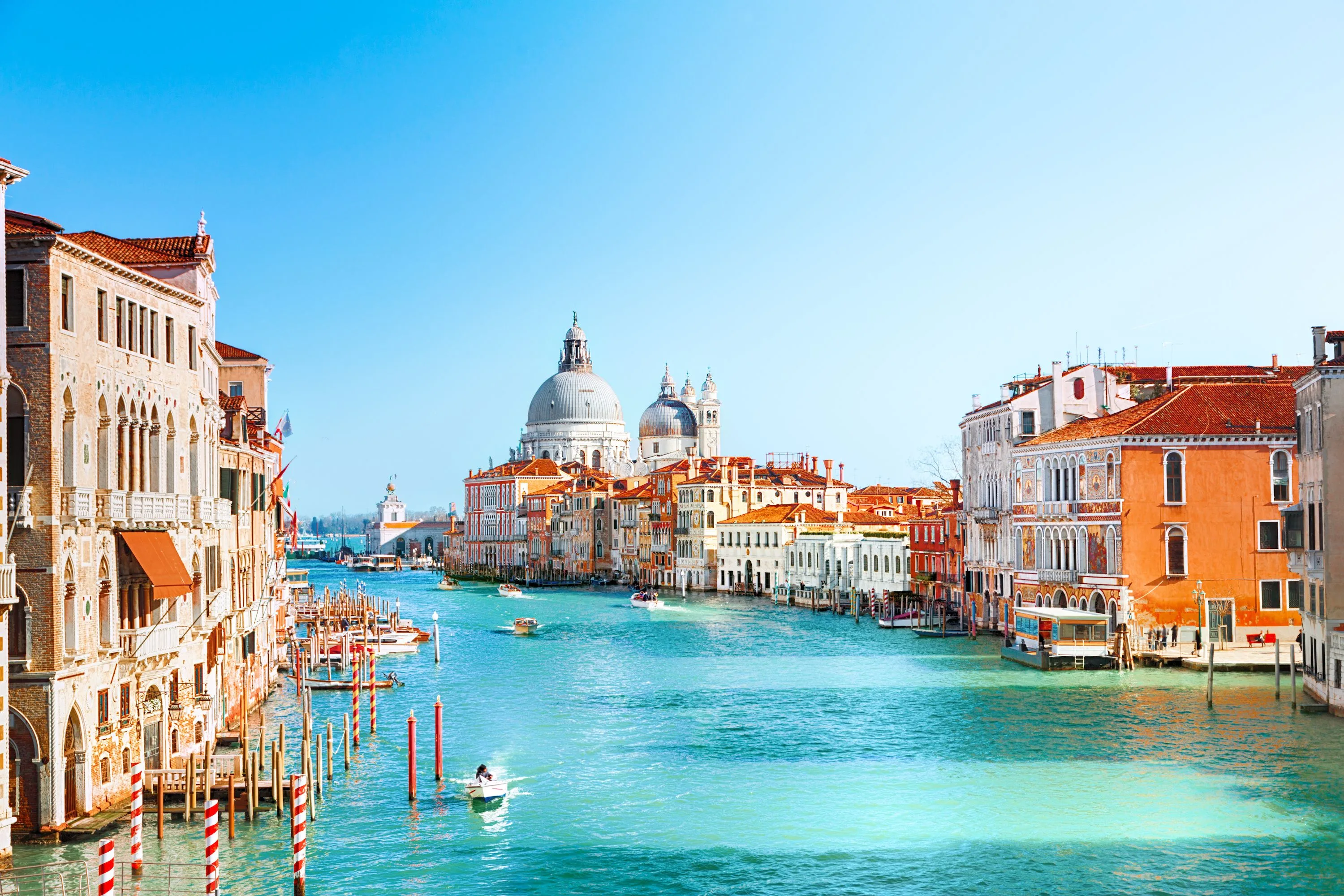
Ponte dell'Accademia
 Highlight of The Dorsoduro District
Highlight of The Dorsoduro DistrictCatch the iconic photo of the Grand Canal from the this attractive wood and metal bridge.
As one of only four bridges to span the Grand Canal, the Ponte dell'Accademia bridge, located right next to the Gallerie Dell'Accademia, is an important pedestrian thoroughfare and a popular spot for taking the iconic Grand Canal photograph.

Gallerie Dell'Accademia
 Highlight of The Dorsoduro District
Highlight of The Dorsoduro DistrictSee the incredible masterpieces held within Venice's most renowned art gallery.
Filled with some of the very best 13th- to 18th-century Venetian artwork, this is one of the most important art galleries in Italy. Here you can see masterpieces by Giovanni Bellini, Carpaccio, Titian, Tintoretto, Veronese, and Giambattista Tiepolo. There are too many masterpieces to list here, but if time allows you should definitely rent the audioguide and spend some serious time acquainting yourself with Venice's glorious art heritage. The galleries occupy the former church and convent of Santa Maria della Carità and the adjoining Scuola Grande della Carità, which was the oldest of the six "scuole grandi" – lay confraternities dedicated to charitable works. Dating back to 1343 AD, the Carità was mostly destroyed by fire, but two of its richly decorated rooms can still be seen. The other scuole grandi were also important art patrons and collectors, and many of their greatest works have also ended up in the Accademia.

The Gesuati
 Highlight of The Dorsoduro District
Highlight of The Dorsoduro DistrictWatch the sun set from the steps of this beautifully decorated 18th-century church.
The Church of Gesuati, or Santa Maria del Rosario, sits directly on the large Giudecca Canal and its steps are a favorite spot to catch the last of the sun's rays. Located on the waterfront area known as the Zattere, its a lively scene with several vaporetto stops and many nearby al fresco cafes. The interior gives you a good opportunity to acquaint yourself with the best known and successful of Venice's 18th-century painters, Giambattista Tiepolo, who frescoed the ceiling and painted the scene on the first south altar. Almost all its sculpture and paintings were created within a thirty-year period, making it an excellent time capsule of the mid-1700's. Construction began in 1725, the church was consecrated in 1743, and the last sculptural decoration was in place by 1755. Its highlight is the preserved ceiling paintings and the four large sculptures on the exterior facade, that represent Prudence, Justice, Fortitude and Temperance.

Peggy Guggenheim Collection
 Highlight of The Dorsoduro District
Highlight of The Dorsoduro DistrictSee the rich collection of 20th-century art inside one of Europe's most important museums.
The Peggy Guggenheim Museum is one of the top sights in Venice, not just for art lovers. Housed in the Palazzo Venier dei Leoni, this was the former residence of the flamboyant copper heiress Peggy Guggenheim from 1949 until her death 30 years later. It houses masterpieces ranging from Cubism and Surrealism to Abstract Expressionism from artists such as Magritte, Picasso, Ernst and Miro.

Ca' Rezzonico
 Highlight of The Dorsoduro District
Highlight of The Dorsoduro DistrictAcquaint yourself with Venetian art of the 18th century and get a taste of what it was like to live in a fabulously ornate palace.
Ca' Rezzonico is one of the most important 17th-18th-century palaces in Venice, abd it now houses the Museo del Settecento Veneziano, the city's collection of 18th-century art. Apart from some wonderful paintings by Tiepolo in addition to his ceiling frescoes, the museum also contains Venetian scenes painted by the brilliant landscape artist, Canaletto. Of course it is not just the art hanging on the walls that visitors come for, but the artistry of the building itself. The beautifully decorated interior, including colorful frescoes and ornate marble staircases, is well worth seeing in its own right.

Ponte dell'Accademia
 Highlight of The Dorsoduro District
Highlight of The Dorsoduro DistrictCatch the iconic photo of the Grand Canal from the this attractive wood and metal bridge.
As one of only four bridges to span the Grand Canal, the Ponte dell'Accademia bridge, located right next to the Gallerie Dell'Accademia, is an important pedestrian thoroughfare and a popular spot for taking the iconic Grand Canal photograph.

Gallerie Dell'Accademia
 Highlight of The Dorsoduro District
Highlight of The Dorsoduro DistrictSee the incredible masterpieces held within Venice's most renowned art gallery.
Filled with some of the very best 13th- to 18th-century Venetian artwork, this is one of the most important art galleries in Italy. Here you can see masterpieces by Giovanni Bellini, Carpaccio, Titian, Tintoretto, Veronese, and Giambattista Tiepolo. There are too many masterpieces to list here, but if time allows you should definitely rent the audioguide and spend some serious time acquainting yourself with Venice's glorious art heritage. The galleries occupy the former church and convent of Santa Maria della Carità and the adjoining Scuola Grande della Carità, which was the oldest of the six "scuole grandi" – lay confraternities dedicated to charitable works. Dating back to 1343 AD, the Carità was mostly destroyed by fire, but two of its richly decorated rooms can still be seen. The other scuole grandi were also important art patrons and collectors, and many of their greatest works have also ended up in the Accademia.

The Gesuati
 Highlight of The Dorsoduro District
Highlight of The Dorsoduro DistrictWatch the sun set from the steps of this beautifully decorated 18th-century church.
The Church of Gesuati, or Santa Maria del Rosario, sits directly on the large Giudecca Canal and its steps are a favorite spot to catch the last of the sun's rays. Located on the waterfront area known as the Zattere, its a lively scene with several vaporetto stops and many nearby al fresco cafes. The interior gives you a good opportunity to acquaint yourself with the best known and successful of Venice's 18th-century painters, Giambattista Tiepolo, who frescoed the ceiling and painted the scene on the first south altar. Almost all its sculpture and paintings were created within a thirty-year period, making it an excellent time capsule of the mid-1700's. Construction began in 1725, the church was consecrated in 1743, and the last sculptural decoration was in place by 1755. Its highlight is the preserved ceiling paintings and the four large sculptures on the exterior facade, that represent Prudence, Justice, Fortitude and Temperance.

Peggy Guggenheim Collection
 Highlight of The Dorsoduro District
Highlight of The Dorsoduro DistrictSee the rich collection of 20th-century art inside one of Europe's most important museums.
The Peggy Guggenheim Museum is one of the top sights in Venice, not just for art lovers. Housed in the Palazzo Venier dei Leoni, this was the former residence of the flamboyant copper heiress Peggy Guggenheim from 1949 until her death 30 years later. It houses masterpieces ranging from Cubism and Surrealism to Abstract Expressionism from artists such as Magritte, Picasso, Ernst and Miro.
prev
next

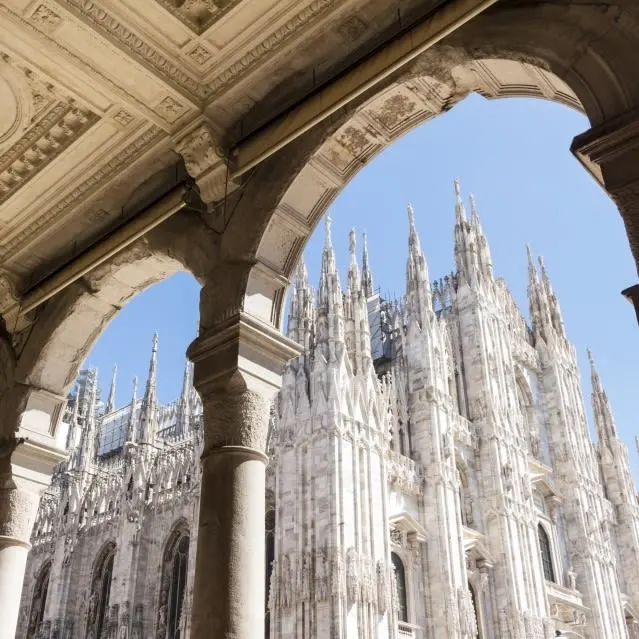
Day 10
Milan
View More
Day 10
Milan




9:00 AM - 12:00 PM
Best of Milan Private Walking Tour
Milan is the center of business and the capital of Italian fashion, but it also has an ancient heritage and a fascinating history; here you find some of the greatest masterpieces of Italian art! Together with your guide, you’ll explore the magnificent Duomo, Galleria, Scala opera house, merchant square, financial district, food street, and Sforza Castle.

La Scala Opera House
Take a tour or experience an opera or ballet in this world-famous opera house.
Show More

Sforza Castle
A huge Medieval-Renaissance fortress with a number of interesting history and art museums
Show More

Galleria Vittorio Emanuele II
Take a stroll through this ornate covered shopping mall that was completed in 1877.
Show More

La Scala Opera House
Take a tour or experience an opera or ballet in this world-famous opera house.
Show More

Sforza Castle
A huge Medieval-Renaissance fortress with a number of interesting history and art museums
Show More

Galleria Vittorio Emanuele II
Take a stroll through this ornate covered shopping mall that was completed in 1877.
Show More

La Scala Opera House
Take a tour or experience an opera or ballet in this world-famous opera house.
Show More
prev
next

Day 10
Milan
View More

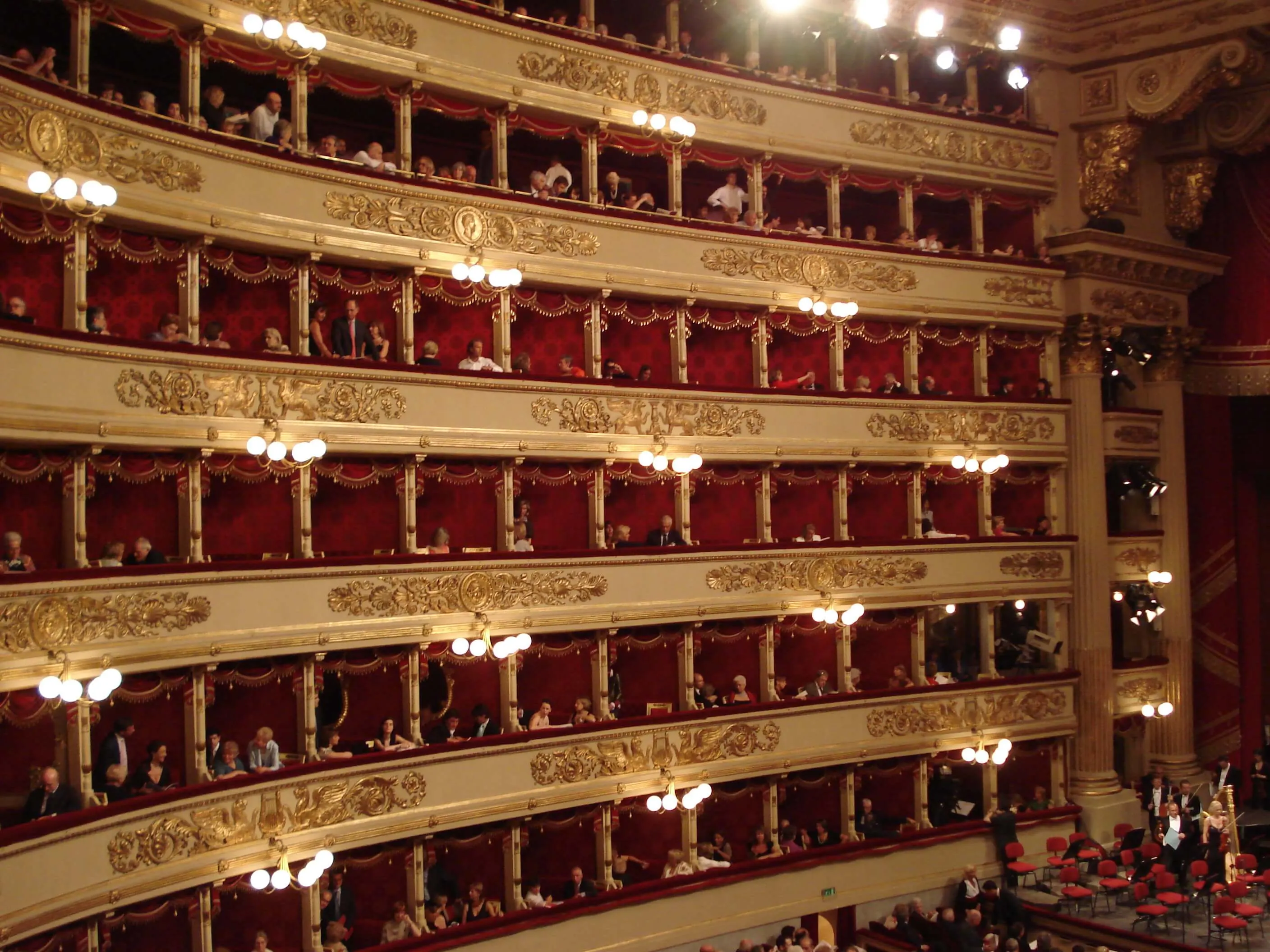
La Scala Opera House
 Highlight of Guided Walk in Milan
Highlight of Guided Walk in MilanTake a tour or experience an opera or ballet in this world-famous opera house.
Considered one of the most important and famous theatres in the world, known as the ‘Temple of Opera’, La Scala has hosted the most revered names in the world of music and theatre. Many famous operas have had their first production in La Scala, such as Othello, Nabucco by Verdi or Madame Butterfly by Giacomo Puccini. While seeing a performance is the best way to experience the theater, visiting the Theatre Museum or taking a guided tour which includes the museum are also great options. In addition to a large collection of paintings, busts, costumes, and other objects related to the world of opera and theater, you will get to see parts of La Scala which are otherwise off limits, like the boxes. Unless a rehearsal or show is in progress, visitors can even watch the set-moving machinery in action.
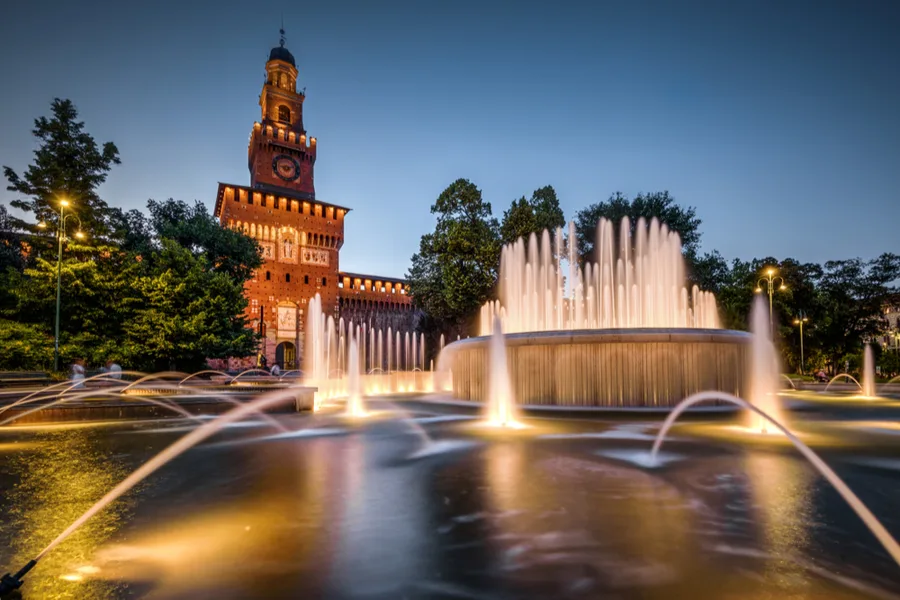
Sforza Castle
 Highlight of Guided Walk in Milan
Highlight of Guided Walk in MilanA huge Medieval-Renaissance fortress with a number of interesting history and art museums
The Sforzesco Castle, one of the most popular monuments in Milan, has undergone various and complex transformations over the centuries; it has been defense fortress, military barracks, private residence and now a center of cultural institutions with several specialized museums and galleries that hold important fragments of Milan's cultural and civic history.
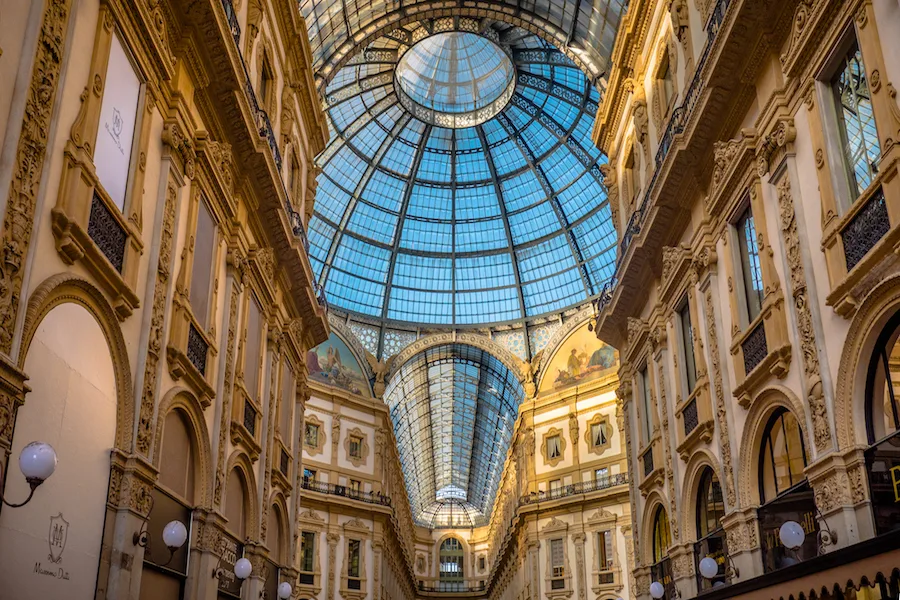
Galleria Vittorio Emanuele II
 Highlight of Guided Walk in Milan
Highlight of Guided Walk in MilanTake a stroll through this ornate covered shopping mall that was completed in 1877.
Known as the "drawing room" of Milan, due to its numerous shops and importance as a common Milanese meeting and dining place, the Galleria Vittorio Emanuele II is Italy's oldest active shopping mall and a major landmark in the city. It is one of the most magnificent shopping arcades in the world, home to some of the most luxurious boutiques and brands including Prada, Armani, Gucci.

La Scala Opera House
 Highlight of Guided Walk in Milan
Highlight of Guided Walk in MilanTake a tour or experience an opera or ballet in this world-famous opera house.
Considered one of the most important and famous theatres in the world, known as the ‘Temple of Opera’, La Scala has hosted the most revered names in the world of music and theatre. Many famous operas have had their first production in La Scala, such as Othello, Nabucco by Verdi or Madame Butterfly by Giacomo Puccini. While seeing a performance is the best way to experience the theater, visiting the Theatre Museum or taking a guided tour which includes the museum are also great options. In addition to a large collection of paintings, busts, costumes, and other objects related to the world of opera and theater, you will get to see parts of La Scala which are otherwise off limits, like the boxes. Unless a rehearsal or show is in progress, visitors can even watch the set-moving machinery in action.

Sforza Castle
 Highlight of Guided Walk in Milan
Highlight of Guided Walk in MilanA huge Medieval-Renaissance fortress with a number of interesting history and art museums
The Sforzesco Castle, one of the most popular monuments in Milan, has undergone various and complex transformations over the centuries; it has been defense fortress, military barracks, private residence and now a center of cultural institutions with several specialized museums and galleries that hold important fragments of Milan's cultural and civic history.

Galleria Vittorio Emanuele II
 Highlight of Guided Walk in Milan
Highlight of Guided Walk in MilanTake a stroll through this ornate covered shopping mall that was completed in 1877.
Known as the "drawing room" of Milan, due to its numerous shops and importance as a common Milanese meeting and dining place, the Galleria Vittorio Emanuele II is Italy's oldest active shopping mall and a major landmark in the city. It is one of the most magnificent shopping arcades in the world, home to some of the most luxurious boutiques and brands including Prada, Armani, Gucci.

La Scala Opera House
 Highlight of Guided Walk in Milan
Highlight of Guided Walk in MilanTake a tour or experience an opera or ballet in this world-famous opera house.
Considered one of the most important and famous theatres in the world, known as the ‘Temple of Opera’, La Scala has hosted the most revered names in the world of music and theatre. Many famous operas have had their first production in La Scala, such as Othello, Nabucco by Verdi or Madame Butterfly by Giacomo Puccini. While seeing a performance is the best way to experience the theater, visiting the Theatre Museum or taking a guided tour which includes the museum are also great options. In addition to a large collection of paintings, busts, costumes, and other objects related to the world of opera and theater, you will get to see parts of La Scala which are otherwise off limits, like the boxes. Unless a rehearsal or show is in progress, visitors can even watch the set-moving machinery in action.
prev
next


Day 11
Milan
View More
Day 11
Milan


Morning to Late Afternoon
Self Guided Excursion to Lake Como
Often cited as the most picturesque lake in Europe, Lake Como has enchanted artists and travelers for centuries and it's easy to see why. Tucked away in the foothills of the northern Italian Alps, Lake Como is the perfect day trip destination from Milan, offering the perfect chance to escape the hustle and bustle of city life. Discover some of the picturesque lakeside villages, take a thrilling boat ride across the lake, or explore the many grand villas and beautiful gardens.

Villa Cipressi
Explore the lush gardens surrounding this villa and enjoy stunning lake views from its terraces.
Show More

Lake Como Funicular
Ride a 19th Century funicular up the mountainside above Como to enjoy beautiful views over Lake Como.
Show More

Cruise on Lake Como
Take a liesurely private sail, enjoy a lake cruise, or villa hop by ferry.
Show More

Bellagio
Visit Lake Como's most famously beautiful lakeside town.
Show More

Cathedral of Como
Admire the wonderful details of this grand Duomo which incorporates architectural styles from across five centuries.
Show More

Villa Melzi
Wander through the magnificent lakeside gardens which surround this beautiful white villa in Bellagio.
Show More

Villa Monastero
Visit a villa that began as a peaceful lakeside convent and was later transformed into a luxurious residence.
Show More

Villa Cipressi
Explore the lush gardens surrounding this villa and enjoy stunning lake views from its terraces.
Show More

Lake Como Funicular
Ride a 19th Century funicular up the mountainside above Como to enjoy beautiful views over Lake Como.
Show More

Cruise on Lake Como
Take a liesurely private sail, enjoy a lake cruise, or villa hop by ferry.
Show More

Bellagio
Visit Lake Como's most famously beautiful lakeside town.
Show More

Cathedral of Como
Admire the wonderful details of this grand Duomo which incorporates architectural styles from across five centuries.
Show More

Villa Melzi
Wander through the magnificent lakeside gardens which surround this beautiful white villa in Bellagio.
Show More

Villa Monastero
Visit a villa that began as a peaceful lakeside convent and was later transformed into a luxurious residence.
Show More

Villa Cipressi
Explore the lush gardens surrounding this villa and enjoy stunning lake views from its terraces.
Show More
prev
next

Day 11
Milan
View More

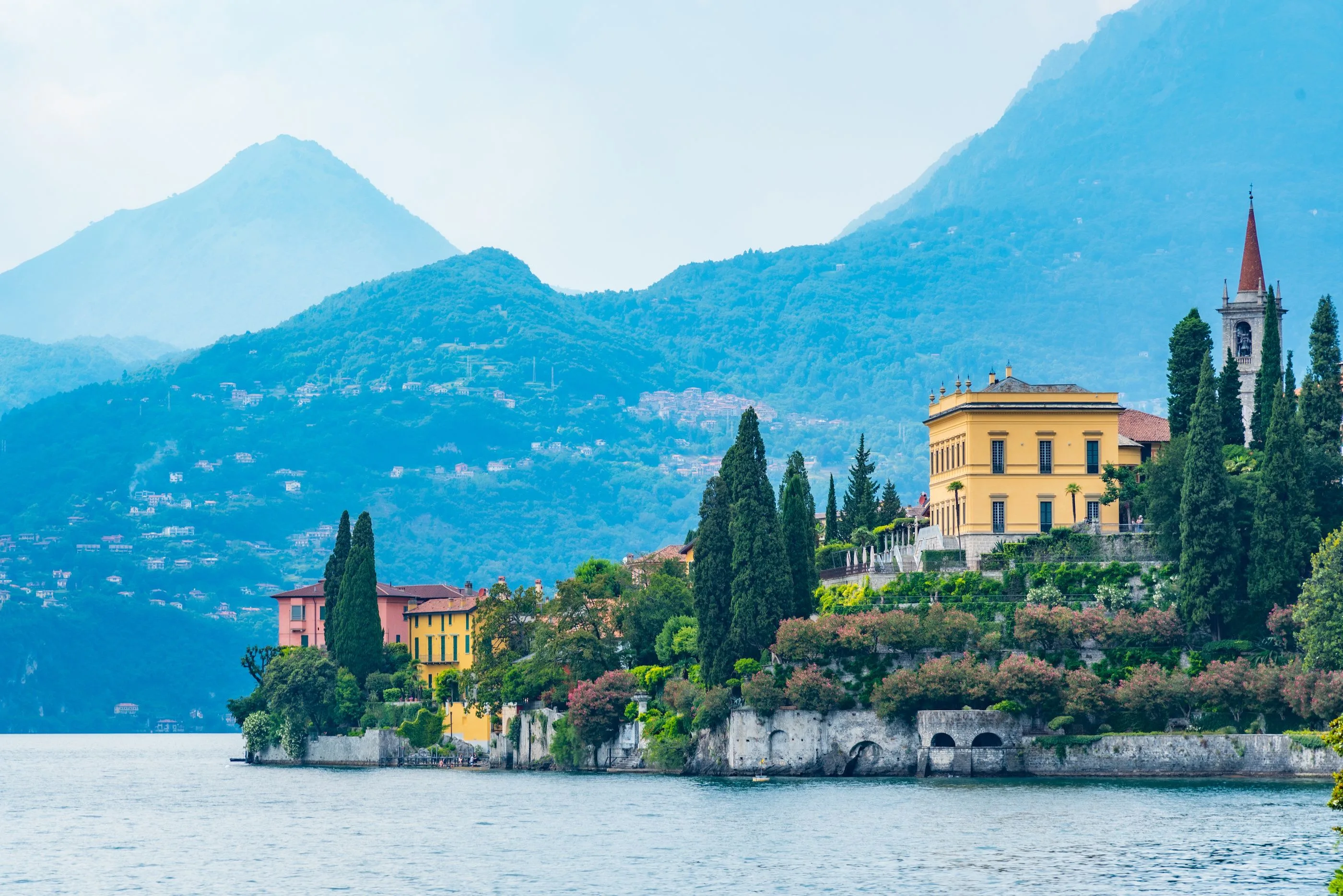
Villa Cipressi
 Highlight of Excursion to Lake Como
Highlight of Excursion to Lake ComoExplore the lush gardens surrounding this villa and enjoy stunning lake views from its terraces.
Just a short distance from Villa Monastero, you'll find the Villa Cirpressi, a grand villa built between the 15th and 19th century which offers great architectural elements of late Renaissance and fine Neoclassical features. Aside from the villa which is now a 4-star hotel, it is home to another manicured lakeside garden. Smaller in size, the centuries-old gardens are open to the public to visit, offering a journey of perfumes and magical sensations that go beyond a normal botanical garden. The terraced garden overlooking the lake deserves a visit, especially for anyone interested in nature.
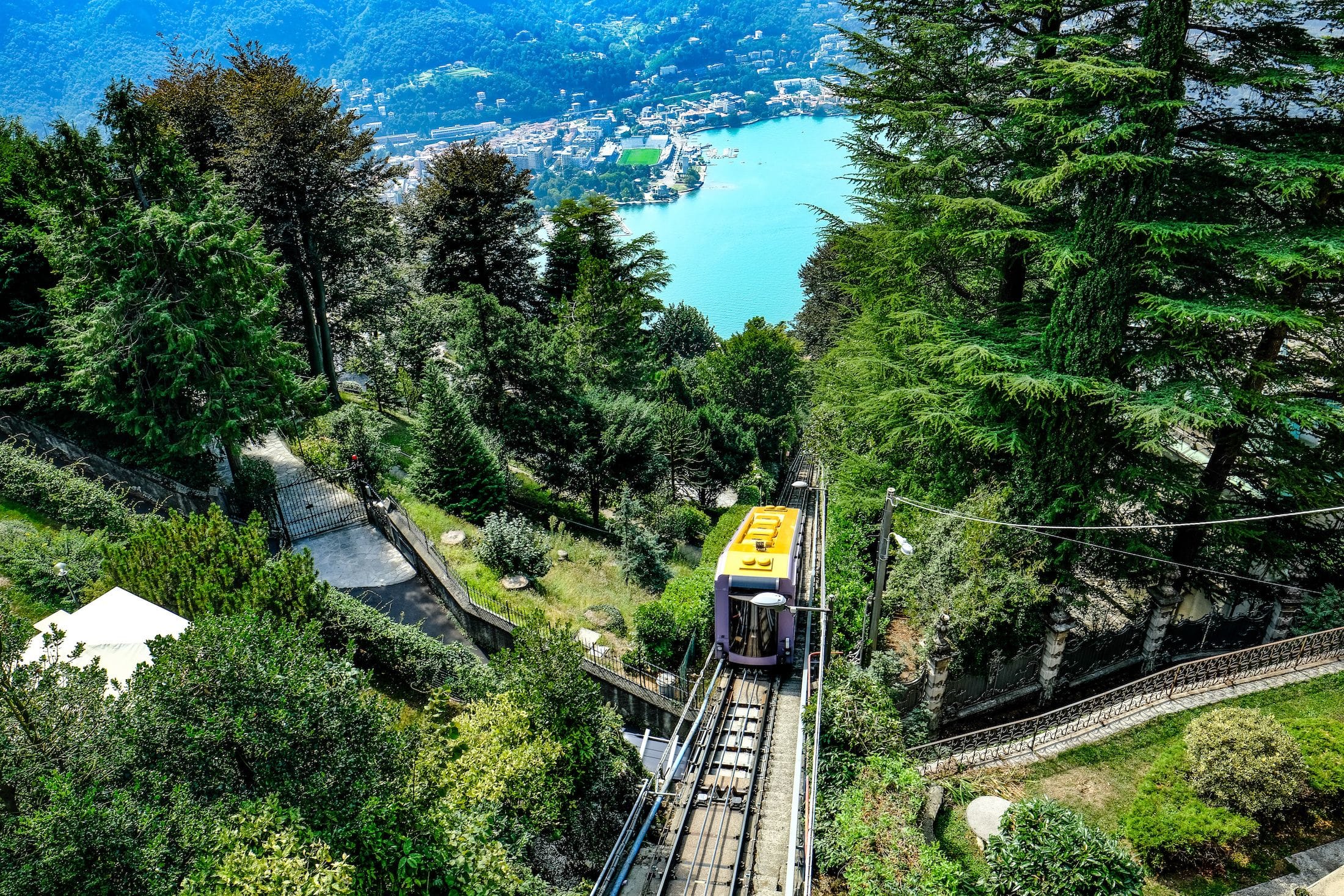
Lake Como Funicular
 Highlight of Excursion to Lake Como
Highlight of Excursion to Lake ComoRide a 19th Century funicular up the mountainside above Como to enjoy beautiful views over Lake Como.
Lake Como is surrounded by beautiful hills and mountains, and while it’s definitely possible to hike up the steep incline on foot, most people opt to ride on the Brunate Funicular, which brings riders to the small town of Brunate in just 7 minutes. The Funicular Railway has linked Lake Como and Brunate since 1894 and is still the quickest way of travelling between these two towns. A trip on the railway offers stunning views and an opportunity to see panoramic views of rural Como, all whilst having an enjoyable jaunt on a train!
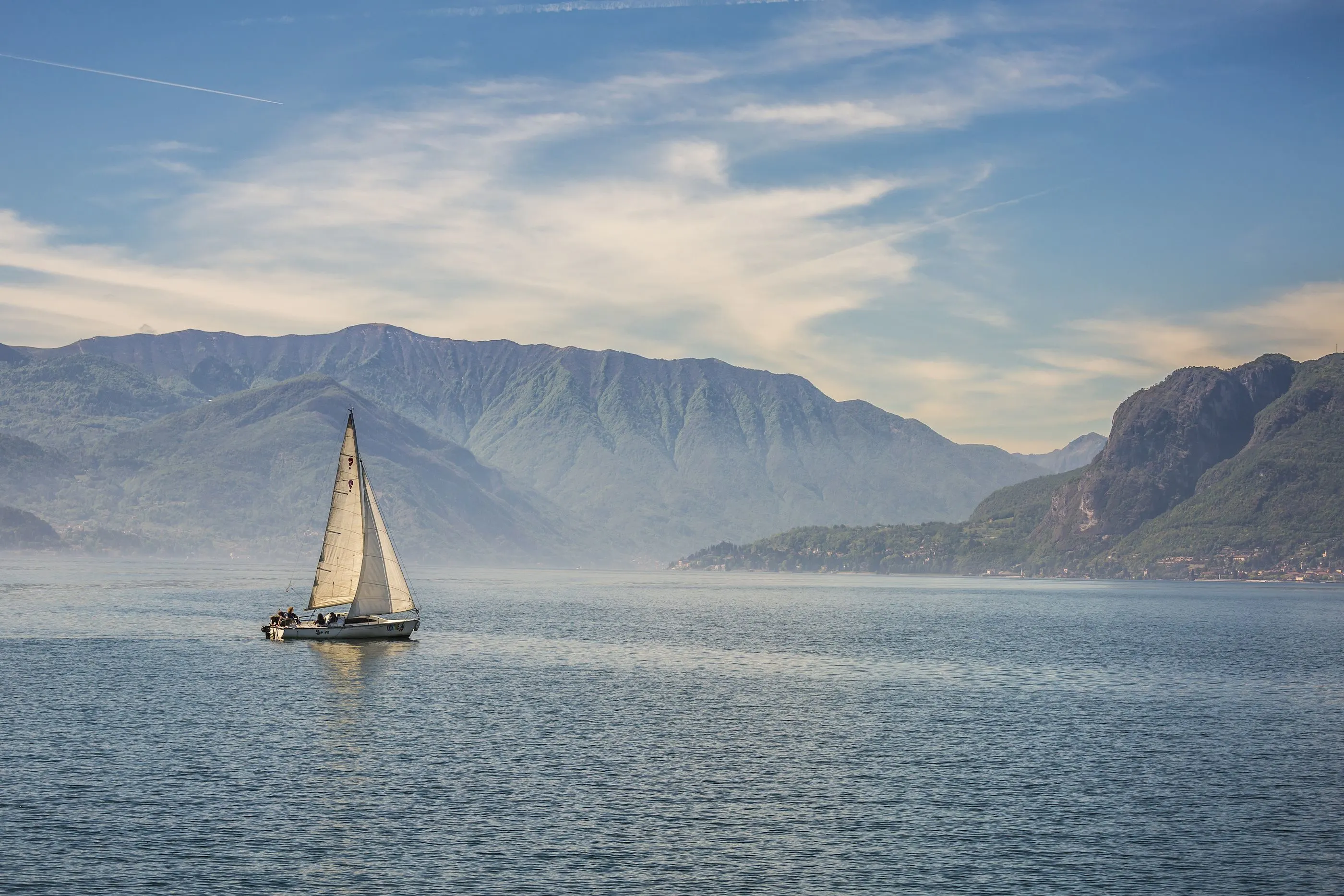
Cruise on Lake Como
 Highlight of Excursion to Lake Como
Highlight of Excursion to Lake ComoTake a liesurely private sail, enjoy a lake cruise, or villa hop by ferry.
One good way to combine a lake cruise with visits to the best villas and prettiest towns is to use the lake ferries. Just take the train from Milan to Varenna and then when you're done there, catch a ferry across the lake to Bellagio. From Bellagio you can take another ferry to Como, where you can catch a train back to Milan. If you go straight to Como, from April to October there are leisure boats offering 30-minute journeys along the nearby shoreline. With a high number of tourists, boats leave quite frequently and are very affordable at around 5 Euros per person. The better boats will point out sites of interest along the way, including spots where famous movies were filmed. If you want a truly special experience, you can also hire a private tour on a sail boat or small motor yacht. You'll feel like a real movie star as the you glide across the blue waters of the lake and wave to your fellow celebrities in the passing boats.
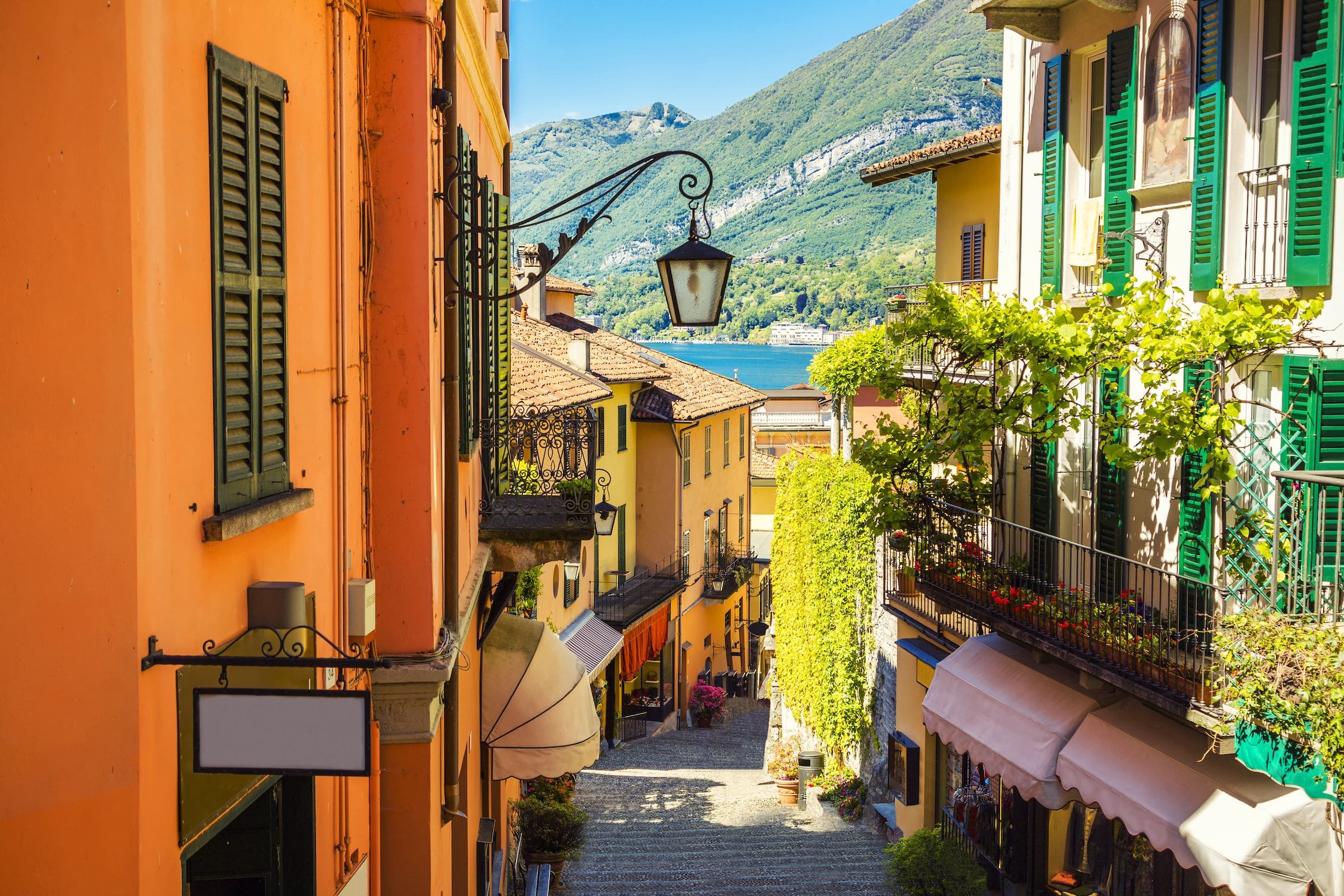
Bellagio
 Highlight of Excursion to Lake Como
Highlight of Excursion to Lake ComoVisit Lake Como's most famously beautiful lakeside town.
It is impossible not to be smitten by Bellagio's picturesque waterfront, bobbing boats and its maze of stone staircases, alleys, and cypress tree groves, and you may want to spend the most time during your day trip here. Bellagio has been a favored summertime resort since the Roman Times, and very little has changed, with Italians and tourists heading to the lakes for a cooler (but still incredibly warm) climate, away from the sweltering heat of the cities.

Cathedral of Como
 Highlight of Excursion to Lake Como
Highlight of Excursion to Lake ComoAdmire the wonderful details of this grand Duomo which incorporates architectural styles from across five centuries.
The imposing cathedral (Duomo) is located in the heart of Como's medieval walled city. Built between 1300 and 1744, the cathedral brings together elements of several architectural styles, including the late Gothic structure, the Renaissance facade, and the imposing Baroque dome. The front façade boasts an abundance of ornate stonework and stone statues, and is topped with a series of small decorative towers. The interior is also lavishly decorated. The standout feature is a central dome covered with gold artwork and other beautiful decor.

Villa Melzi
 Highlight of Excursion to Lake Como
Highlight of Excursion to Lake ComoWander through the magnificent lakeside gardens which surround this beautiful white villa in Bellagio.
The town of Bellagio was fought over in wars between Como and Milan, but most of the time, it has been a destination of pleasure and leisure since late Roman times. For this reason, Napoleon decided to reward one of his generals, Francesco Melzi, with the white neo-Classical Villa Melzi. Located to the south of the Bellagio, it is visited primarily for its spectacular gardens, embellished with ancient artefacts such as an Etruscan urn that dates back to the 3rd Century BC and two ancient Egyptian sculptures.
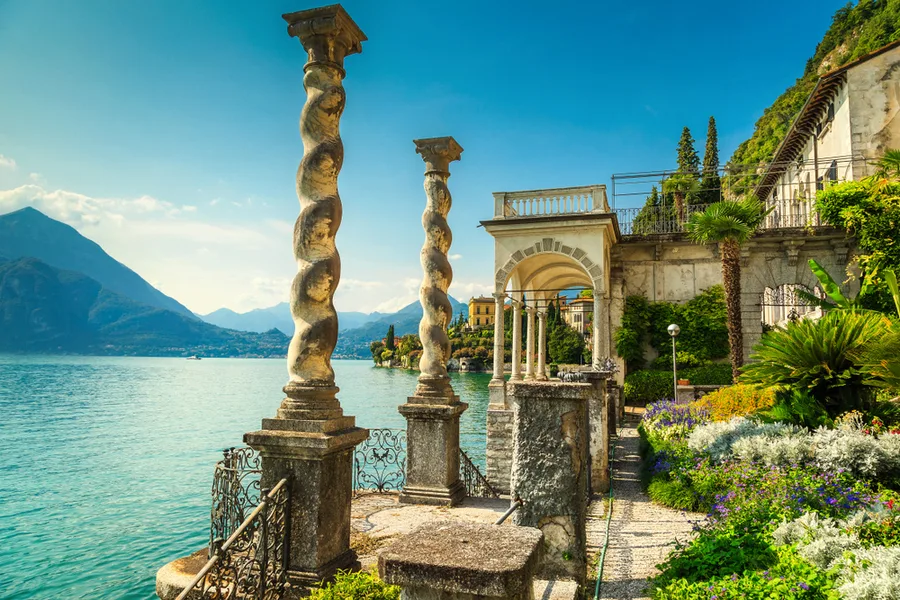
Villa Monastero
 Highlight of Excursion to Lake Como
Highlight of Excursion to Lake ComoVisit a villa that began as a peaceful lakeside convent and was later transformed into a luxurious residence.
Built-in various styles (Baroque, Classic and Moresque), the origins of the Villa Monastero in the town of Varenna stretch back to the 12th century, when it was founded as a Cistercian convent. The estate was purchased by Paolo Mornico in 1569, using his fortune amassed through iron mining. He then transformed it into a very elaborate aristocratic residence, while retaining some beautiful elements from the convent. These days the villa is now used as an international conference center and wedding venue. Luckily for visitors, the gardens are open to the public and there is also a House Museum, which features 14 lavish rooms filled with period furniture, refined decorations, and luxurious furnishings.

Villa Cipressi
 Highlight of Excursion to Lake Como
Highlight of Excursion to Lake ComoExplore the lush gardens surrounding this villa and enjoy stunning lake views from its terraces.
Just a short distance from Villa Monastero, you'll find the Villa Cirpressi, a grand villa built between the 15th and 19th century which offers great architectural elements of late Renaissance and fine Neoclassical features. Aside from the villa which is now a 4-star hotel, it is home to another manicured lakeside garden. Smaller in size, the centuries-old gardens are open to the public to visit, offering a journey of perfumes and magical sensations that go beyond a normal botanical garden. The terraced garden overlooking the lake deserves a visit, especially for anyone interested in nature.

Lake Como Funicular
 Highlight of Excursion to Lake Como
Highlight of Excursion to Lake ComoRide a 19th Century funicular up the mountainside above Como to enjoy beautiful views over Lake Como.
Lake Como is surrounded by beautiful hills and mountains, and while it’s definitely possible to hike up the steep incline on foot, most people opt to ride on the Brunate Funicular, which brings riders to the small town of Brunate in just 7 minutes. The Funicular Railway has linked Lake Como and Brunate since 1894 and is still the quickest way of travelling between these two towns. A trip on the railway offers stunning views and an opportunity to see panoramic views of rural Como, all whilst having an enjoyable jaunt on a train!

Cruise on Lake Como
 Highlight of Excursion to Lake Como
Highlight of Excursion to Lake ComoTake a liesurely private sail, enjoy a lake cruise, or villa hop by ferry.
One good way to combine a lake cruise with visits to the best villas and prettiest towns is to use the lake ferries. Just take the train from Milan to Varenna and then when you're done there, catch a ferry across the lake to Bellagio. From Bellagio you can take another ferry to Como, where you can catch a train back to Milan. If you go straight to Como, from April to October there are leisure boats offering 30-minute journeys along the nearby shoreline. With a high number of tourists, boats leave quite frequently and are very affordable at around 5 Euros per person. The better boats will point out sites of interest along the way, including spots where famous movies were filmed. If you want a truly special experience, you can also hire a private tour on a sail boat or small motor yacht. You'll feel like a real movie star as the you glide across the blue waters of the lake and wave to your fellow celebrities in the passing boats.

Bellagio
 Highlight of Excursion to Lake Como
Highlight of Excursion to Lake ComoVisit Lake Como's most famously beautiful lakeside town.
It is impossible not to be smitten by Bellagio's picturesque waterfront, bobbing boats and its maze of stone staircases, alleys, and cypress tree groves, and you may want to spend the most time during your day trip here. Bellagio has been a favored summertime resort since the Roman Times, and very little has changed, with Italians and tourists heading to the lakes for a cooler (but still incredibly warm) climate, away from the sweltering heat of the cities.

Cathedral of Como
 Highlight of Excursion to Lake Como
Highlight of Excursion to Lake ComoAdmire the wonderful details of this grand Duomo which incorporates architectural styles from across five centuries.
The imposing cathedral (Duomo) is located in the heart of Como's medieval walled city. Built between 1300 and 1744, the cathedral brings together elements of several architectural styles, including the late Gothic structure, the Renaissance facade, and the imposing Baroque dome. The front façade boasts an abundance of ornate stonework and stone statues, and is topped with a series of small decorative towers. The interior is also lavishly decorated. The standout feature is a central dome covered with gold artwork and other beautiful decor.

Villa Melzi
 Highlight of Excursion to Lake Como
Highlight of Excursion to Lake ComoWander through the magnificent lakeside gardens which surround this beautiful white villa in Bellagio.
The town of Bellagio was fought over in wars between Como and Milan, but most of the time, it has been a destination of pleasure and leisure since late Roman times. For this reason, Napoleon decided to reward one of his generals, Francesco Melzi, with the white neo-Classical Villa Melzi. Located to the south of the Bellagio, it is visited primarily for its spectacular gardens, embellished with ancient artefacts such as an Etruscan urn that dates back to the 3rd Century BC and two ancient Egyptian sculptures.

Villa Monastero
 Highlight of Excursion to Lake Como
Highlight of Excursion to Lake ComoVisit a villa that began as a peaceful lakeside convent and was later transformed into a luxurious residence.
Built-in various styles (Baroque, Classic and Moresque), the origins of the Villa Monastero in the town of Varenna stretch back to the 12th century, when it was founded as a Cistercian convent. The estate was purchased by Paolo Mornico in 1569, using his fortune amassed through iron mining. He then transformed it into a very elaborate aristocratic residence, while retaining some beautiful elements from the convent. These days the villa is now used as an international conference center and wedding venue. Luckily for visitors, the gardens are open to the public and there is also a House Museum, which features 14 lavish rooms filled with period furniture, refined decorations, and luxurious furnishings.

Villa Cipressi
 Highlight of Excursion to Lake Como
Highlight of Excursion to Lake ComoExplore the lush gardens surrounding this villa and enjoy stunning lake views from its terraces.
Just a short distance from Villa Monastero, you'll find the Villa Cirpressi, a grand villa built between the 15th and 19th century which offers great architectural elements of late Renaissance and fine Neoclassical features. Aside from the villa which is now a 4-star hotel, it is home to another manicured lakeside garden. Smaller in size, the centuries-old gardens are open to the public to visit, offering a journey of perfumes and magical sensations that go beyond a normal botanical garden. The terraced garden overlooking the lake deserves a visit, especially for anyone interested in nature.
prev
next


Day 12
Depart Milan
View More
Day 12
Depart Milan

To Be Determined
Transfer to Airport by Taxi. Train or Bus
There are three main airports in Milan. You will likely depart from Malpensa although you may also depart from Milano Bergamo or Milano Linate if you are flying within Europe. The most affordable and fast way to reach Milan Malpensa airport is by train. The Malpensa Express train takes only 35 minutes and leaves directly from the main Centrale station in central Milan. The most affordable way to reach Milan Bergamo airport is by bus. The bus takes about 1 hour and leaves directly from Milano Centrale Train Station in central Milan. To reach Linate Airport you are best taking a taxi as it is only 10km from the city center. Your hotel can arrange a reliable taxi or if you have the app, Uber is also a good option. You can also arrange a private transfer. If you are picked up about 4 hours before your departure time, you should arrive at the Malpensa or Bergamo airport with about 3 hours to spare, depending on traffic. If you are leaving during rush hour, you may want to budget an extra fifteen to thirty minutes.

Day 12
Depart Milan
View More


What's Included In Your Trip

Pre-Paid Tours and Activities:
- Heart of the Empire - Private Tour of Ancient Rome & the Colosseum
- Best of Florence: Half-Day Walking Tour
- 'First Walk' Guided Tour in Venice
- Private Gondola Ride
- Best of Milan Private Walking Tour
- City Card for Rome, including discounts to many popular attractions

Pre-Paid Transportation:
- 2nd Class Train Tickets from Rome-Florence
- 2nd Class Train Tickets from Florence-Venice
- 2nd Class Train Tickets from Venice-Milan
- Public Transport Tickets for Venice and Rome
- Private Transfer from Rome Fiumicino to Hotel
- Private Transfer to Rome Termini Train Station

Accommodation:
- 4 nights at a hotel of your choice in Rome
- 4 nights at a hotel of your choice in Florence
- 3 nights at a hotel of your choice in Venice
- 4 nights at a hotel of your choice in Milan

Go Real Travel Mobile App:
- Itinerary Plan & Reservations Info
- Points of Interest
- Detailed Travel Information
- Maps & Directions
Other Trips You May Like

14 Days
From$3559USD

10 Days
From$4033USD

8 Days
From$2424USD

12 Days
From$3129USD

12 Days
From$2999USD

15 Days
From$4266USD

14 Days
From$3847USD

21 Days
From$6990USD

7 Days
From$2139USD

14 Days
From$3559USD

10 Days
From$4033USD

8 Days
From$2424USD

12 Days
From$3129USD

12 Days
From$2999USD

15 Days
From$4266USD

14 Days
From$3847USD

21 Days
From$6990USD

7 Days
From$2139USD
prev
next
Featured Blogs
prev
next
Our Customers Say It Best
Otto Chuy, Los Angeles, California
I am still surprised how everything worked as planned, without a hitch. All instructions in your itinerary were precise and correct. Your suggestions and comments in each of the locations we went to were very helpful. All your guides, without exception, were wonderful and exactly on time. 

Kathy Mongeau, Ottawa, Ontario
My sister, Ann Ibberson, and I have been back home for a few weeks now and still go on and on about our fabulous trip. We were just blown away in every respect. Given the fact that we only had 1 ½ weeks, you had everything arranged for us so efficiently and your contacts who we dealt with for transfers, tours, hotels were extremely professional and personable. Things could not have gone better. 

Clive Andrew, Brisbane, Queensland
Just a quick note to let you know that I am back home now after probably the best overseas holiday that I have ever had, in no small part due to your very capable organization booking of hotels, tours, & trains. There was just nothing that went wrong with the timings etc. 

Malini Dutta, Boston, Massachusetts
We can't thank you enough for the detailed plans, maps, and suggestions. It really felt that someone was holding our hands and showing us around. We had all the excitement of discovering foreign lands, with none of the problems that can happen while negotiating unfamiliar places. In fact, all the cities felt like home within a few hours of arriving and exploring. 

Bev and Mark Frankel, Williamsburg, Virginia
We could not be more pleased with Go Real Travel! You took the guess work out of things like public transport but still managed to allow us the freedom to tour as we wanted. Our guides were exceptional and every time I saw a Viking Cruise tour of 25 people, I realized the quality experience we were getting with Go Real. 

Marianne Strydom, Paarl, South Africa
I just wanted to thank you for organizing an amazing trip for me – I packed in so much in such a short period of time and everything was just perfect. The way you do things makes it possible to really get to know the destination, which for me as a travel agent could not have been better. 

Otto Chuy, Los Angeles, California
I am still surprised how everything worked as planned, without a hitch. All instructions in your itinerary were precise and correct. Your suggestions and comments in each of the locations we went to were very helpful. All your guides, without exception, were wonderful and exactly on time. 

Kathy Mongeau, Ottawa, Ontario
My sister, Ann Ibberson, and I have been back home for a few weeks now and still go on and on about our fabulous trip. We were just blown away in every respect. Given the fact that we only had 1 ½ weeks, you had everything arranged for us so efficiently and your contacts who we dealt with for transfers, tours, hotels were extremely professional and personable. Things could not have gone better. 

Clive Andrew, Brisbane, Queensland
Just a quick note to let you know that I am back home now after probably the best overseas holiday that I have ever had, in no small part due to your very capable organization booking of hotels, tours, & trains. There was just nothing that went wrong with the timings etc. 

Malini Dutta, Boston, Massachusetts
We can't thank you enough for the detailed plans, maps, and suggestions. It really felt that someone was holding our hands and showing us around. We had all the excitement of discovering foreign lands, with none of the problems that can happen while negotiating unfamiliar places. In fact, all the cities felt like home within a few hours of arriving and exploring. 

Bev and Mark Frankel, Williamsburg, Virginia
We could not be more pleased with Go Real Travel! You took the guess work out of things like public transport but still managed to allow us the freedom to tour as we wanted. Our guides were exceptional and every time I saw a Viking Cruise tour of 25 people, I realized the quality experience we were getting with Go Real. 

Marianne Strydom, Paarl, South Africa
I just wanted to thank you for organizing an amazing trip for me – I packed in so much in such a short period of time and everything was just perfect. The way you do things makes it possible to really get to know the destination, which for me as a travel agent could not have been better. 



Explore cities in more detail

Milan
Milan is Italy’s most forward-looking city. An international center for fashion, fine dining, and design, it seems as though Milanese people breathe style. From the gleam on your wine glass to the twists of its cathedral’s spires, everything in Milan is finished to perfection. Home to the Italian stock exchange, a world-famous fashion industry, and a frantic business district, Milan is fast-paced and commercially minded. The shopping in Milan is second to none. At the Galleria Vittorio Emanuele II, one of the world’s oldest shopping malls, a glass-iron ceiling soars over brands like Louis Vuitton, Gucci, Massimo Dutti, and Amani. Along with the fashion, Milan’s cathedral, castle, and canals are also must-sees. But to view the city’s most prized possession - Leonardo da Vinci’s Last Supper, you must make an appointment. Tickets to view this mural sell out weeks in advance. It is truly a bucket-list worthy work of art. After a day taking in all the glamor and culture, take a seat in one of Milan’s well-appointed eateries. The Navigli Quarter is packed with restaurants, bars, and cafes, perfect for a relaxed Aperol spritz or pizza along the city’s canals.
Read More
Learn About Milan
Build Milan Trip

Cinque Terre
Cinque Terre, a string of five fishing villages in the Liguria region of Italy, is a rare snapshot of a traditional way of life. Rustic and charming, these clusters of pastel houses clinging to steep Mediterranean cliffs hold a special allure. Hiking between the five villages is a popular way to experience the rugged Mediterranean landscape close up. There are no roads here — the only other way to get between the villages is by boat or train. Seafood, hauled in from the azure waters of the sea that laps against the rocky shore, is abundant and delicious here. It pairs well with the local wine, and perhaps a plate of olives. Cinque Terre is a place to take it slow, to breathe in the fresh sea air and bask in the balmy climate, many miles from the chaos and frenzy of the modern world.
Read More
Learn About Cinque Terre
Build Cinque Terre Trip
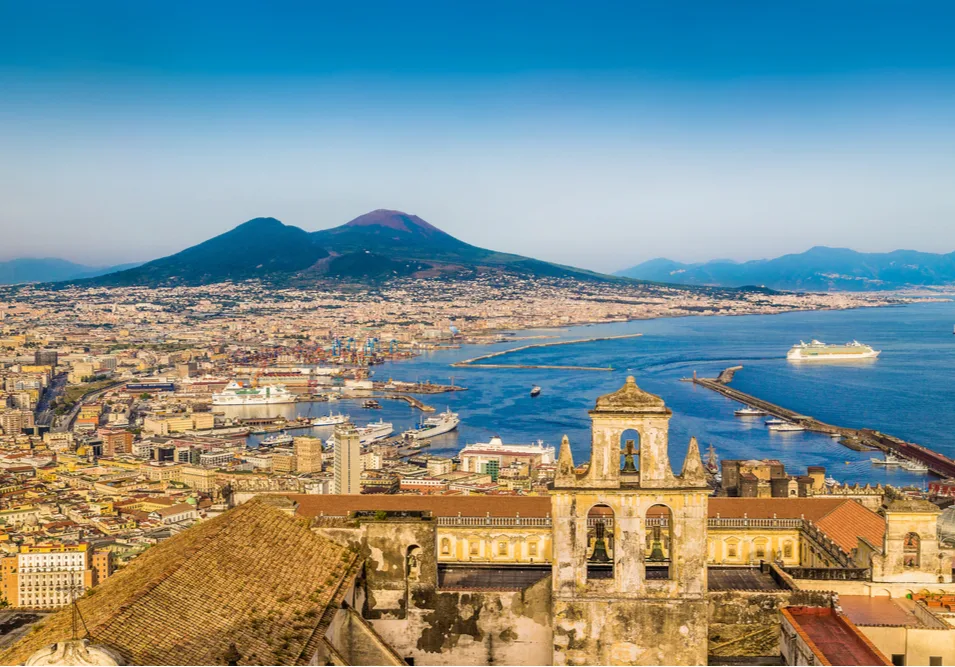
Naples
Gritty and chaotic Naples calls to travelers who want to experience the real Italy. Pressed along the coast of Campania, hilly Naples is jammed with maze-like streets, strung with outdoor clotheslines, descending toward the sea below. A much deserved UNESCO World Heritage site, Naples is famous for its churches, museums, castles, and catacombs. As you navigate the city, you’ll find yourself immersed by its culture and history. You can easily occupy a full day gazing at churches like the Naples Cathedral, San Francesco di Paola, and Cappella Sansevero. If you cast your eyes toward the Gulf of Naples, you’ll see Mount Vesuvius looming over the harbor. This foreboding volcano erupted in AD 79. Not far from the inner city — less than an hour by train — you’ll find the ancient town of Pompeii, its dramatic ruins still preserved in ash from the eruption. One of the best things you can do in Naples is to eat. This is the city where pizza was born. Propped up by its ripe tomatoes, local cheeses, and fresh fish, food from Naples has come to define what many see as the height of Italian cuisine. Everything you taste in Naples seems like a delicacy. Authentic and vivid, Naples is a true Italian city where the ancient world meets the modern-day with a bang.
Read More
Learn About Naples
Build Naples Trip

Rome
One of the must-sees of Italy, and indeed all of Europe, Rome is a city with history flowing through its veins. There is an endless amount to see, do, and learn here, with something for every taste and disposition. Rome was the center of Western civilization for a Millenium and during that time, accumulated a list of historical and cultural treasures that no other destination can truly match. The Pantheon, Colosseum, Roman Forum, and Cirus of Maxentius are just a few examples of what can be seen and experienced in Rome, which at times feels more like a giant outdoor museum than a city. At Rome’s heart, you’ll find the Vatican, home of the Roman Catholic Church and the Pope. Here visitors can see the legendary Sistine Chapel. Transcending a mere building, the chapel is a walk-in work of art. Although historical sights can be found on just about every corner, it’s entirely possible to fill a day just wandering around Rome. The city’s charming streets and open Piazzas are filled with beautiful sights and places to sit, grab the best Cappuccino in the world, and enjoy the view.
Read More
Learn About Rome
Build Rome Trip

Florence
Culture and history are thick in the air in Florence. Located on the banks of the Arno River in Tuscany, Florence’s past is deeply compelling. The birthplace of the Renaissance, Florence is where innovators like Dante, Machiavelli, Michelangelo, and Da Vinci made their fortunes. Centuries of art, politics, and commerce have left their mark on every stone in this Northern Italian city. In the 15th and 16th centuries, Florentine banks funded new enterprises that went on to change the history of the world. Powerful families like the Medici’s financed some of the finest art in history and pioneered new ways of doing statecraft and politics. As you stand in the Piazzale Michelangelo and gaze upon the city below it’s hard to take it all in at once. It feels like behind every door in Florence might hide a work of genius. Michelangelo’s David and Botticelli’s Primavera can be found just a short walk away. After a long day wandering the streets and gazing at art, fueled by exquisite coffee and gelato, relax like the locals do: with a glass of some of the best wine in the world.
Read More
Learn About Florence
Build Florence Trip
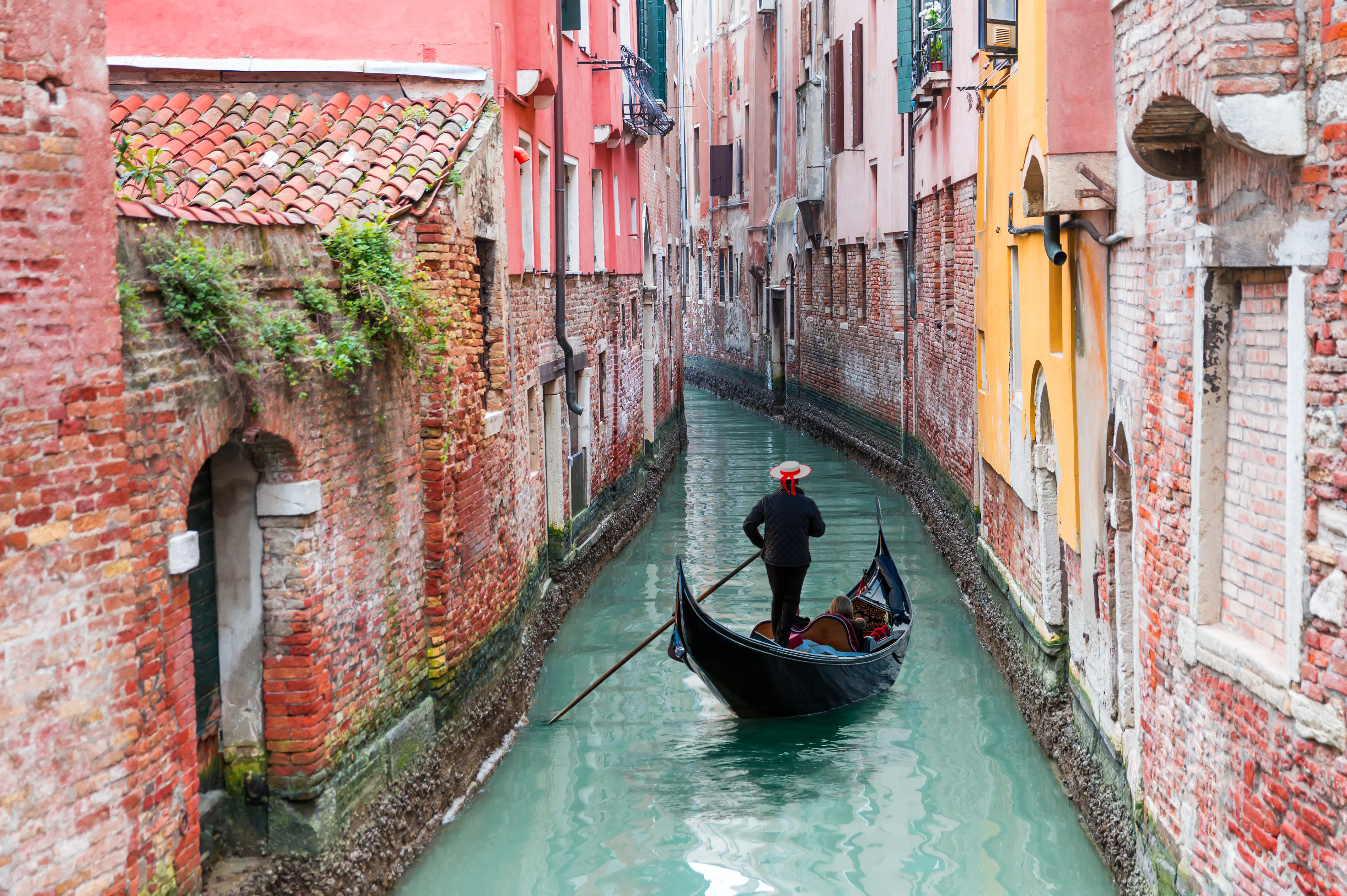
Venice
Venice is a city with no equal. Built on a series of islands on a lagoon, it was once a powerful city-state. Echoes of that old magnificence can be seen everywhere here, from the stunning buildings that rise out of the canals, to the bridges that arc across them. Take a Gondola ride through the canals that form the city’s veins, or wander through the winding streets drinking in the sights. You’ll see Venice attracts tourists in huge numbers, and that’s with good reason. It’s home to a seemingly limitless amount of art, culture, history, and architecture. St Mark’s Basilica, the Doge’s Palace, and the Campanile di San Marco just barely scratch the surface. There’s a 700-year-old market, Rialto, which is still open today. The Ponte di Rialto bridge connects the neighborhoods of San Marco and San Polo, stretching across the Grand Canal. Venice has weathered the last several centuries with elegance and pride, a place that will surpass even your highest expectations.
Read More
Learn About Venice
Build Venice Trip

Milan
Milan is Italy’s most forward-looking city. An international center for fashion, fine dining, and design, it seems as though Milanese people breathe style. From the gleam on your wine glass to the twists of its cathedral’s spires, everything in Milan is finished to perfection. Home to the Italian stock exchange, a world-famous fashion industry, and a frantic business district, Milan is fast-paced and commercially minded. The shopping in Milan is second to none. At the Galleria Vittorio Emanuele II, one of the world’s oldest shopping malls, a glass-iron ceiling soars over brands like Louis Vuitton, Gucci, Massimo Dutti, and Amani. Along with the fashion, Milan’s cathedral, castle, and canals are also must-sees. But to view the city’s most prized possession - Leonardo da Vinci’s Last Supper, you must make an appointment. Tickets to view this mural sell out weeks in advance. It is truly a bucket-list worthy work of art. After a day taking in all the glamor and culture, take a seat in one of Milan’s well-appointed eateries. The Navigli Quarter is packed with restaurants, bars, and cafes, perfect for a relaxed Aperol spritz or pizza along the city’s canals.
Read More
Learn About Milan
Build Milan Trip

Cinque Terre
Cinque Terre, a string of five fishing villages in the Liguria region of Italy, is a rare snapshot of a traditional way of life. Rustic and charming, these clusters of pastel houses clinging to steep Mediterranean cliffs hold a special allure. Hiking between the five villages is a popular way to experience the rugged Mediterranean landscape close up. There are no roads here — the only other way to get between the villages is by boat or train. Seafood, hauled in from the azure waters of the sea that laps against the rocky shore, is abundant and delicious here. It pairs well with the local wine, and perhaps a plate of olives. Cinque Terre is a place to take it slow, to breathe in the fresh sea air and bask in the balmy climate, many miles from the chaos and frenzy of the modern world.
Read More
Learn About Cinque Terre
Build Cinque Terre Trip

Naples
Gritty and chaotic Naples calls to travelers who want to experience the real Italy. Pressed along the coast of Campania, hilly Naples is jammed with maze-like streets, strung with outdoor clotheslines, descending toward the sea below. A much deserved UNESCO World Heritage site, Naples is famous for its churches, museums, castles, and catacombs. As you navigate the city, you’ll find yourself immersed by its culture and history. You can easily occupy a full day gazing at churches like the Naples Cathedral, San Francesco di Paola, and Cappella Sansevero. If you cast your eyes toward the Gulf of Naples, you’ll see Mount Vesuvius looming over the harbor. This foreboding volcano erupted in AD 79. Not far from the inner city — less than an hour by train — you’ll find the ancient town of Pompeii, its dramatic ruins still preserved in ash from the eruption. One of the best things you can do in Naples is to eat. This is the city where pizza was born. Propped up by its ripe tomatoes, local cheeses, and fresh fish, food from Naples has come to define what many see as the height of Italian cuisine. Everything you taste in Naples seems like a delicacy. Authentic and vivid, Naples is a true Italian city where the ancient world meets the modern-day with a bang.
Read More
Learn About Naples
Build Naples Trip

Rome
One of the must-sees of Italy, and indeed all of Europe, Rome is a city with history flowing through its veins. There is an endless amount to see, do, and learn here, with something for every taste and disposition. Rome was the center of Western civilization for a Millenium and during that time, accumulated a list of historical and cultural treasures that no other destination can truly match. The Pantheon, Colosseum, Roman Forum, and Cirus of Maxentius are just a few examples of what can be seen and experienced in Rome, which at times feels more like a giant outdoor museum than a city. At Rome’s heart, you’ll find the Vatican, home of the Roman Catholic Church and the Pope. Here visitors can see the legendary Sistine Chapel. Transcending a mere building, the chapel is a walk-in work of art. Although historical sights can be found on just about every corner, it’s entirely possible to fill a day just wandering around Rome. The city’s charming streets and open Piazzas are filled with beautiful sights and places to sit, grab the best Cappuccino in the world, and enjoy the view.
Read More
Learn About Rome
Build Rome Trip

Florence
Culture and history are thick in the air in Florence. Located on the banks of the Arno River in Tuscany, Florence’s past is deeply compelling. The birthplace of the Renaissance, Florence is where innovators like Dante, Machiavelli, Michelangelo, and Da Vinci made their fortunes. Centuries of art, politics, and commerce have left their mark on every stone in this Northern Italian city. In the 15th and 16th centuries, Florentine banks funded new enterprises that went on to change the history of the world. Powerful families like the Medici’s financed some of the finest art in history and pioneered new ways of doing statecraft and politics. As you stand in the Piazzale Michelangelo and gaze upon the city below it’s hard to take it all in at once. It feels like behind every door in Florence might hide a work of genius. Michelangelo’s David and Botticelli’s Primavera can be found just a short walk away. After a long day wandering the streets and gazing at art, fueled by exquisite coffee and gelato, relax like the locals do: with a glass of some of the best wine in the world.
Read More
Learn About Florence
Build Florence Trip

Venice
Venice is a city with no equal. Built on a series of islands on a lagoon, it was once a powerful city-state. Echoes of that old magnificence can be seen everywhere here, from the stunning buildings that rise out of the canals, to the bridges that arc across them. Take a Gondola ride through the canals that form the city’s veins, or wander through the winding streets drinking in the sights. You’ll see Venice attracts tourists in huge numbers, and that’s with good reason. It’s home to a seemingly limitless amount of art, culture, history, and architecture. St Mark’s Basilica, the Doge’s Palace, and the Campanile di San Marco just barely scratch the surface. There’s a 700-year-old market, Rialto, which is still open today. The Ponte di Rialto bridge connects the neighborhoods of San Marco and San Polo, stretching across the Grand Canal. Venice has weathered the last several centuries with elegance and pride, a place that will surpass even your highest expectations.
Read More
Learn About Venice
Build Venice Trip
prev
next


 Map of Your Itinerary Route
Map of Your Itinerary Route
Zoom In to the cities to see your itinerary in more detail


 4.8
4.8 








